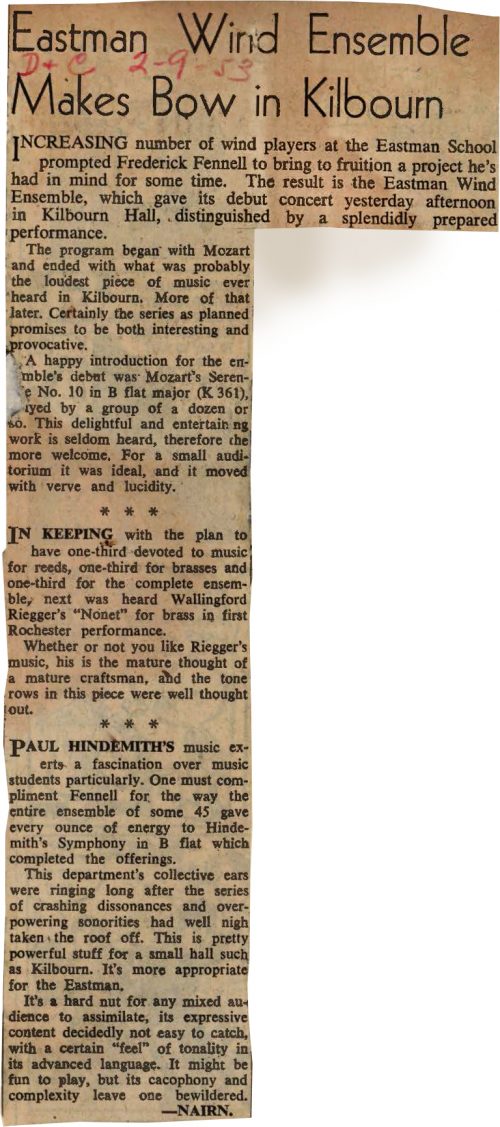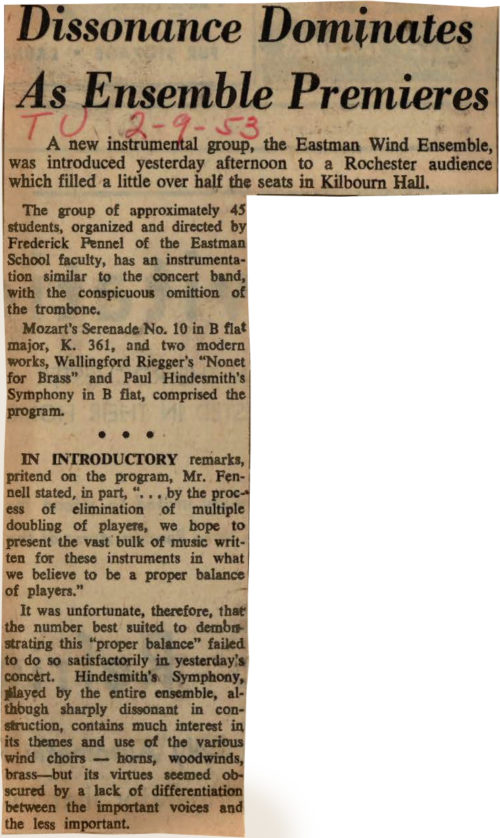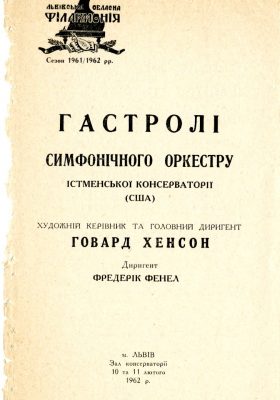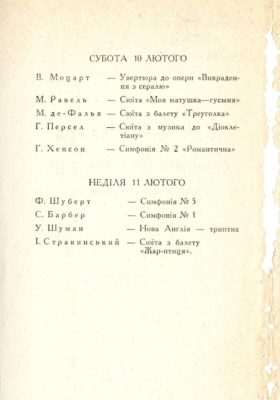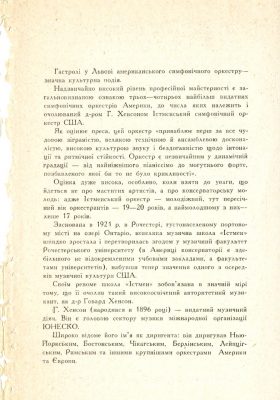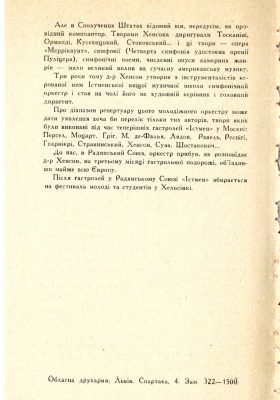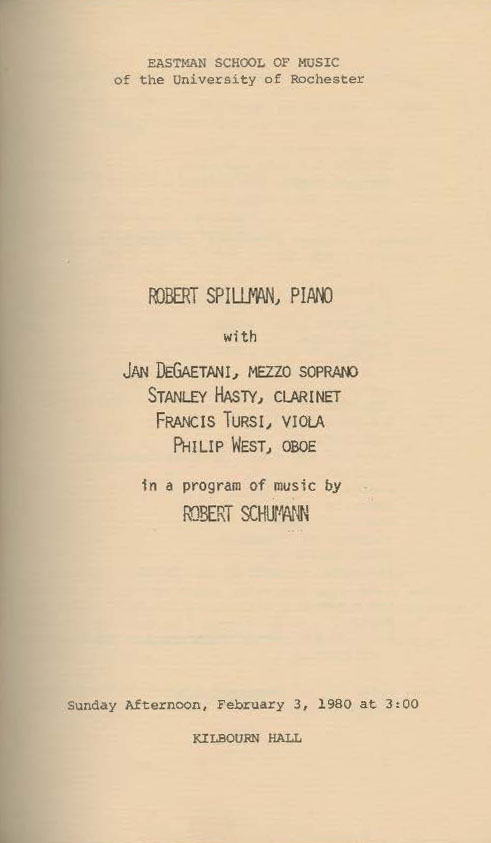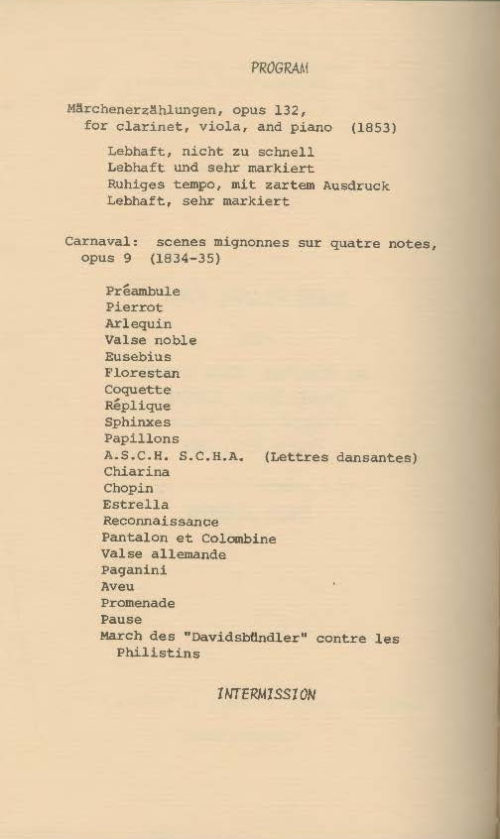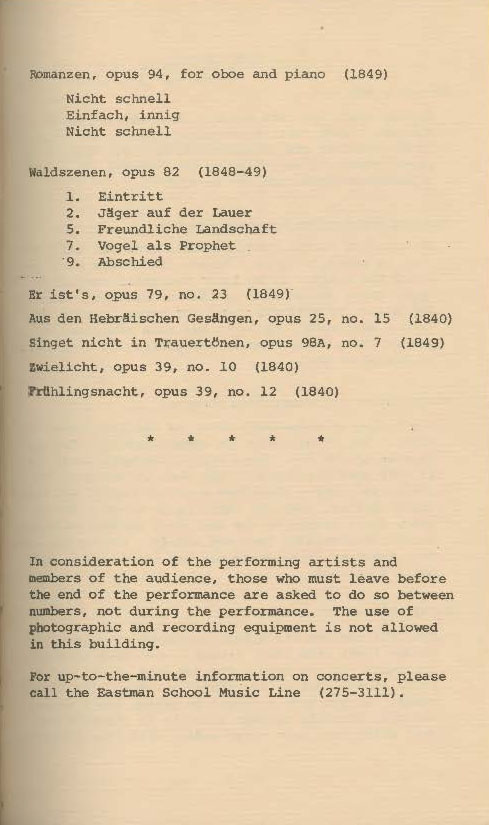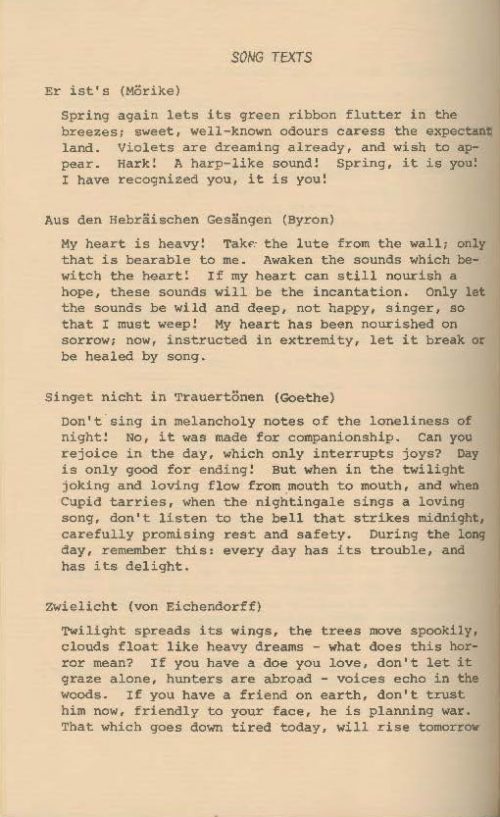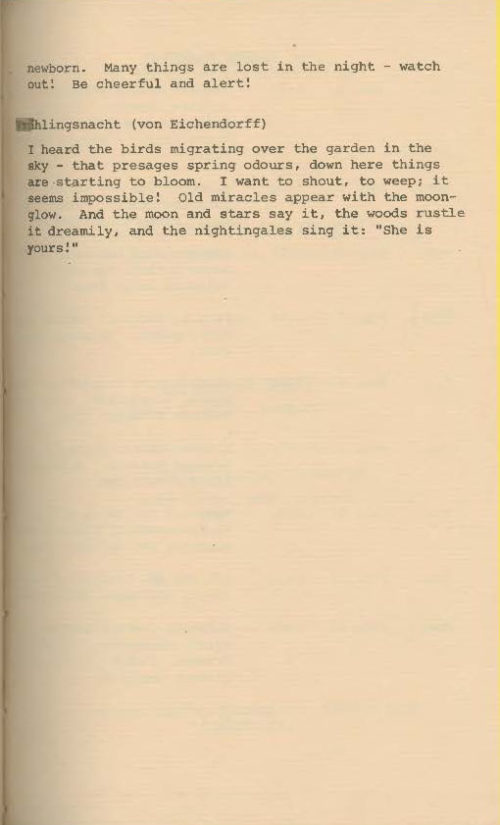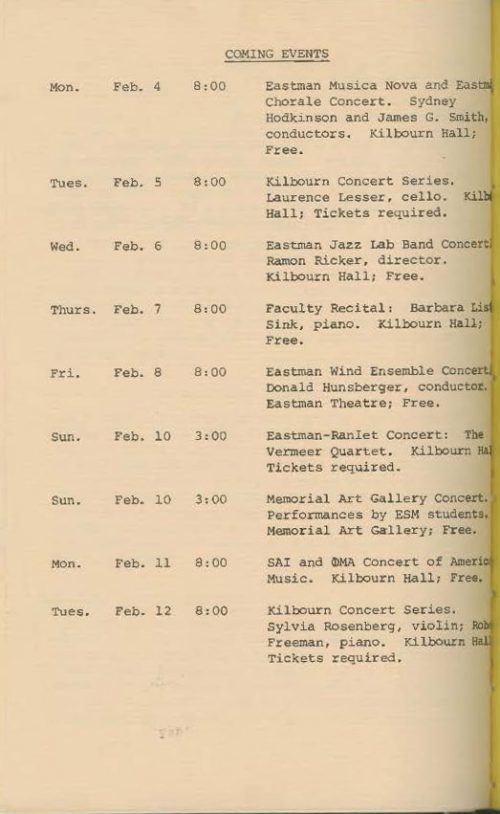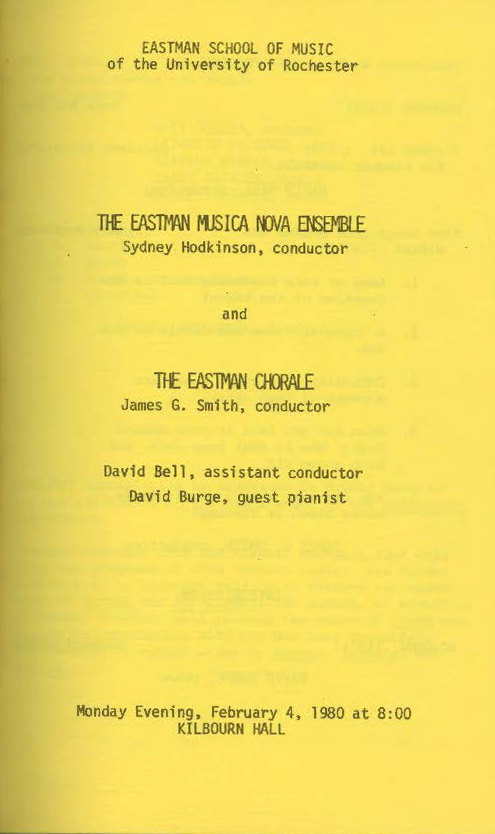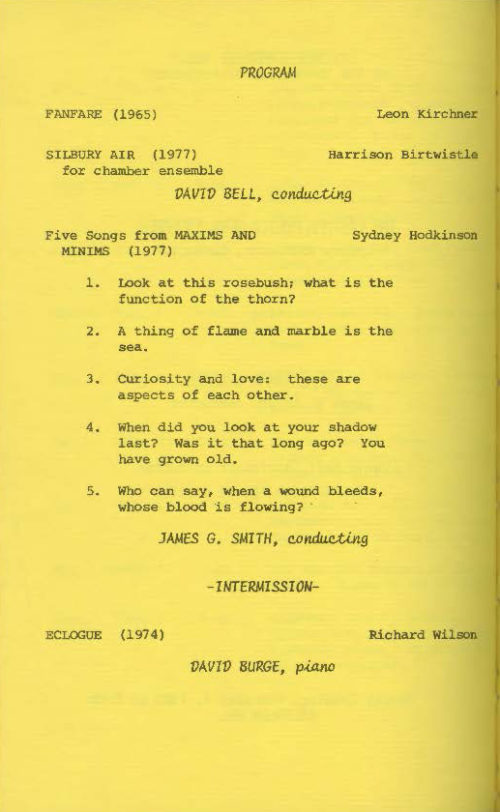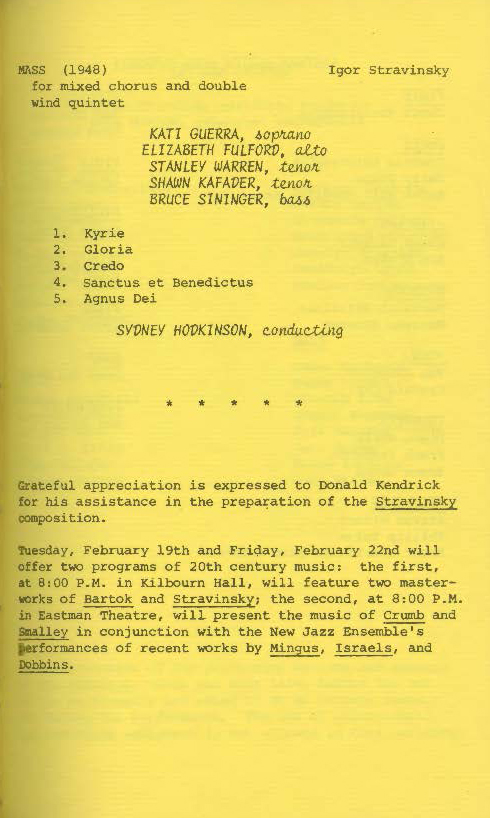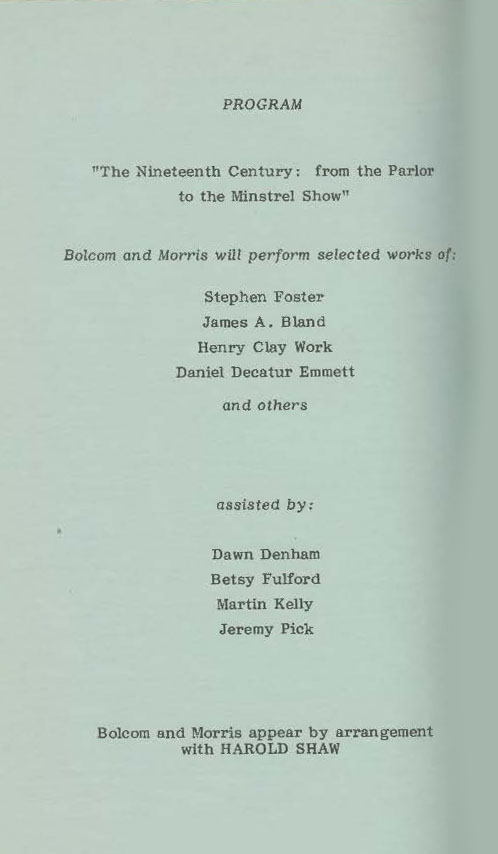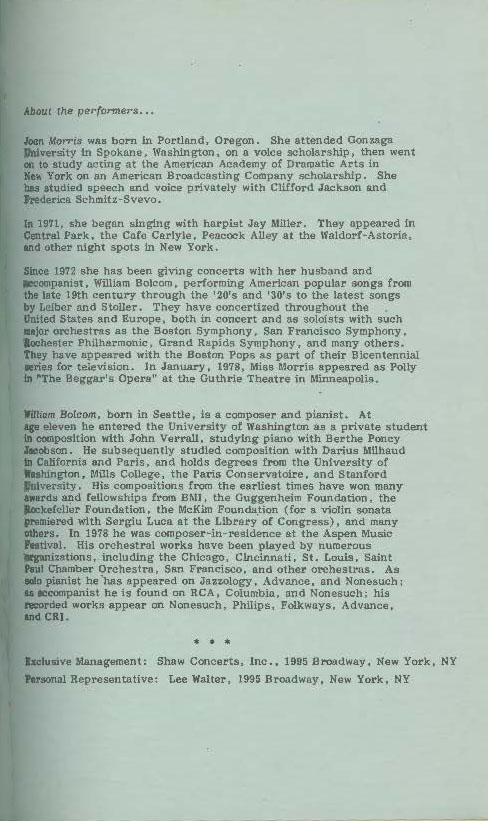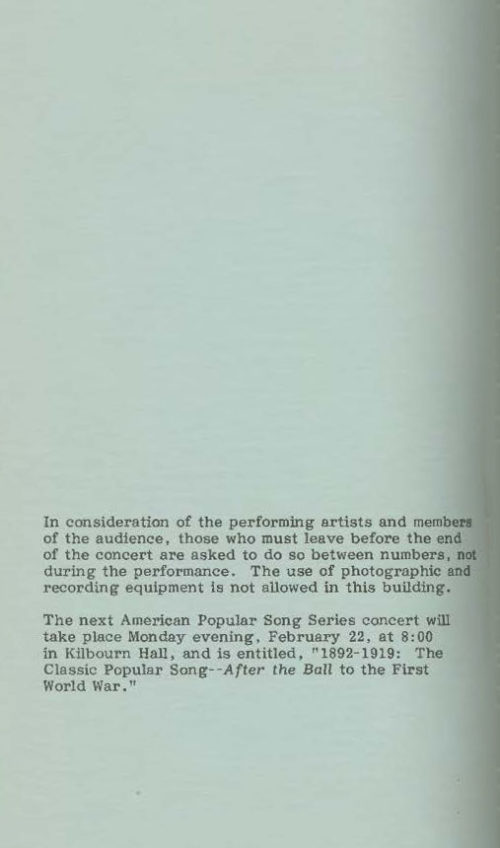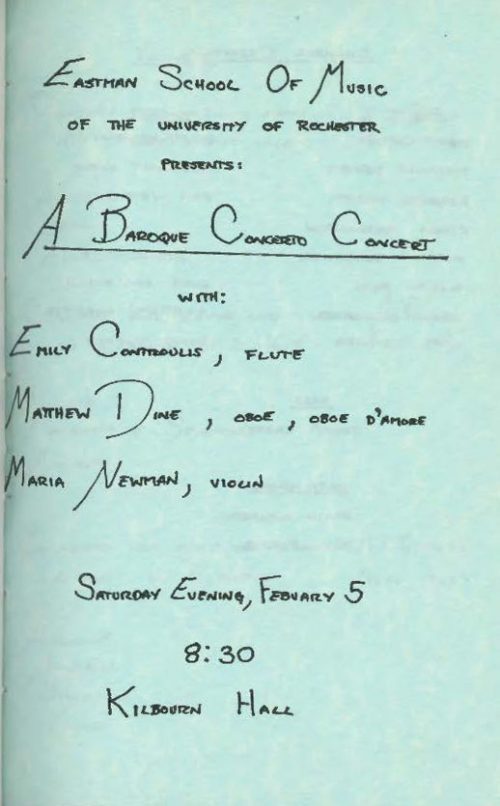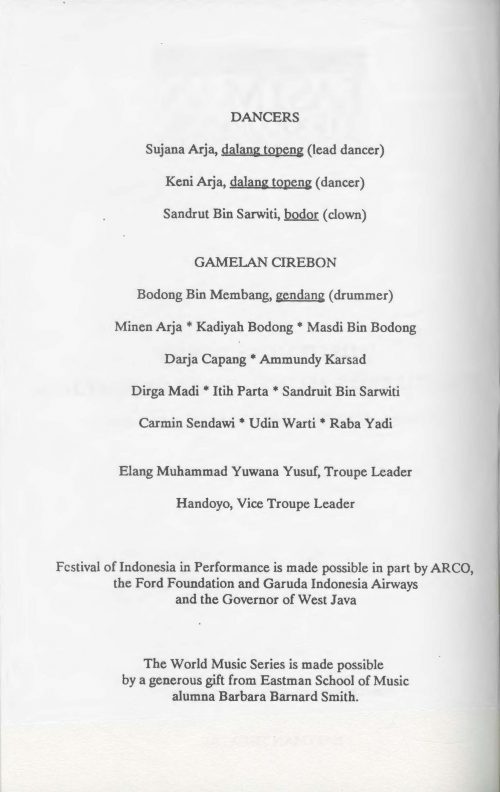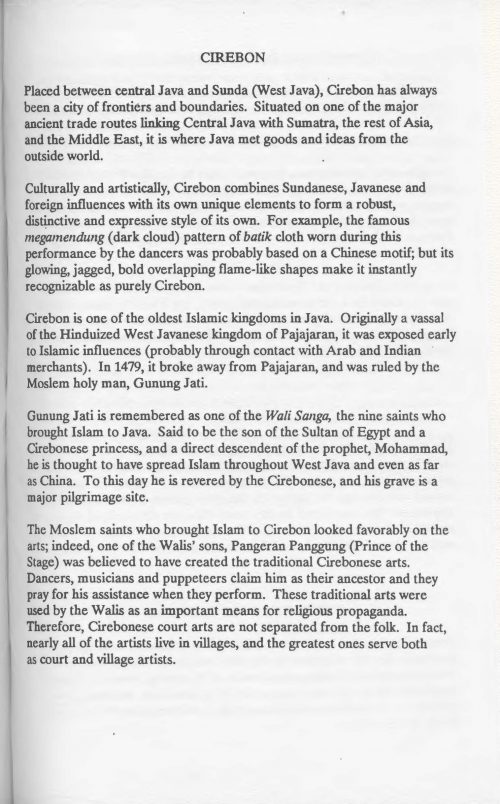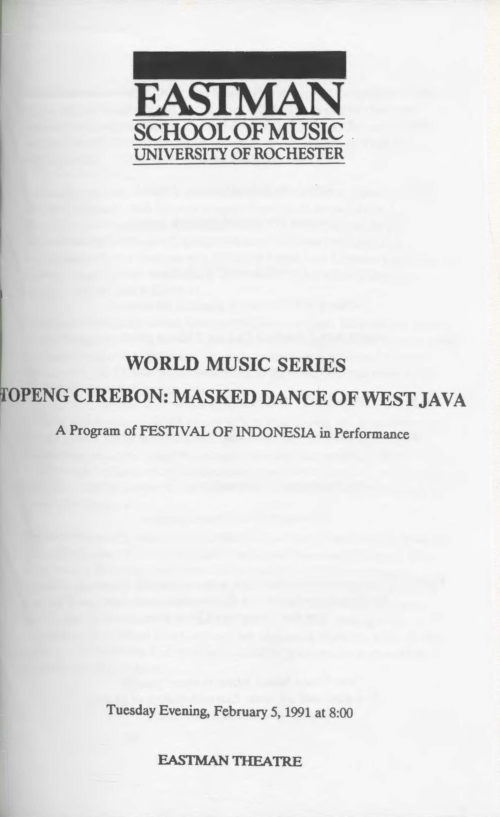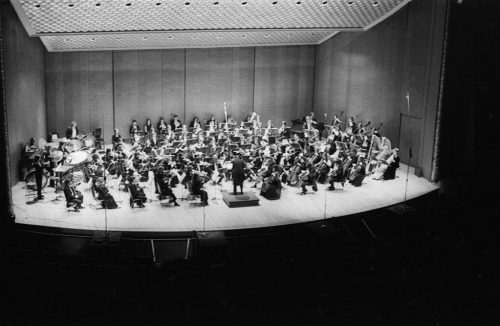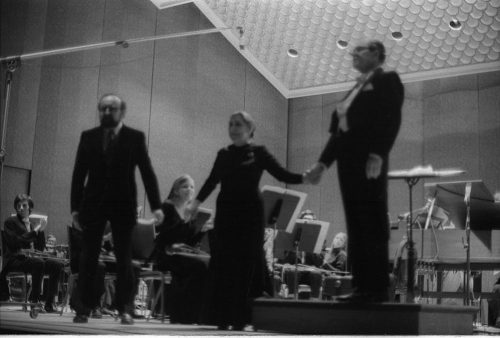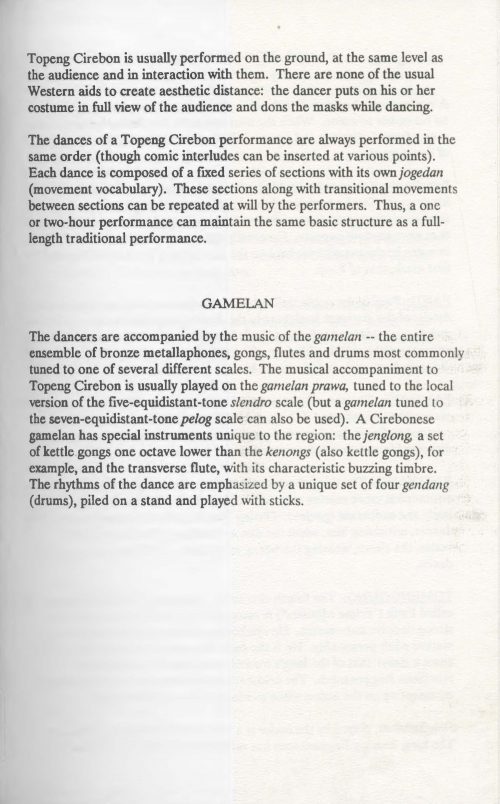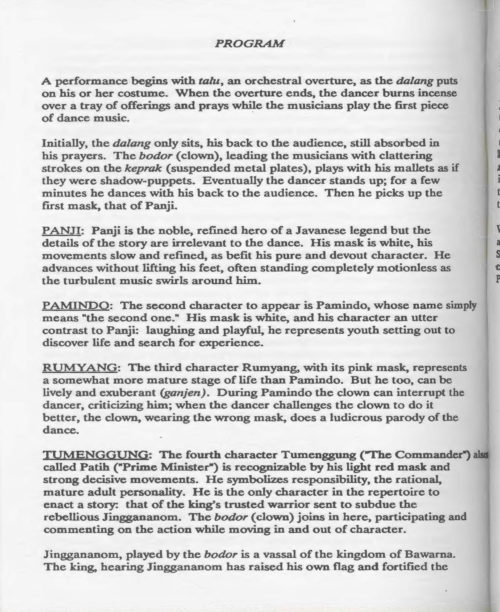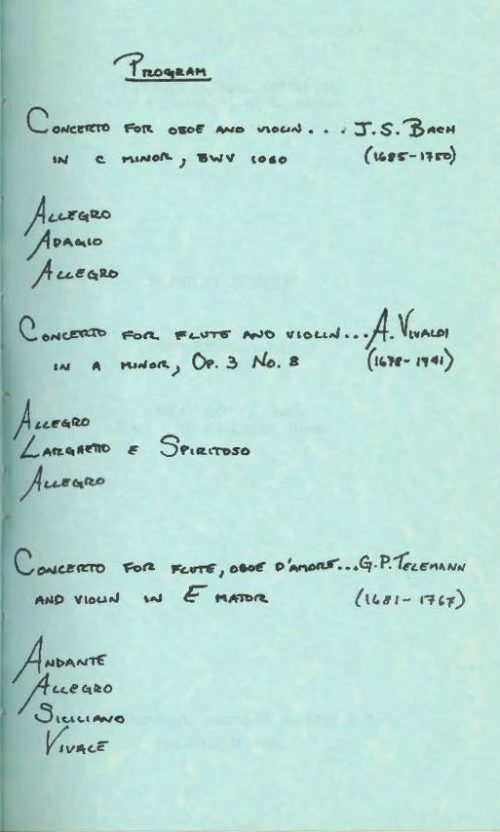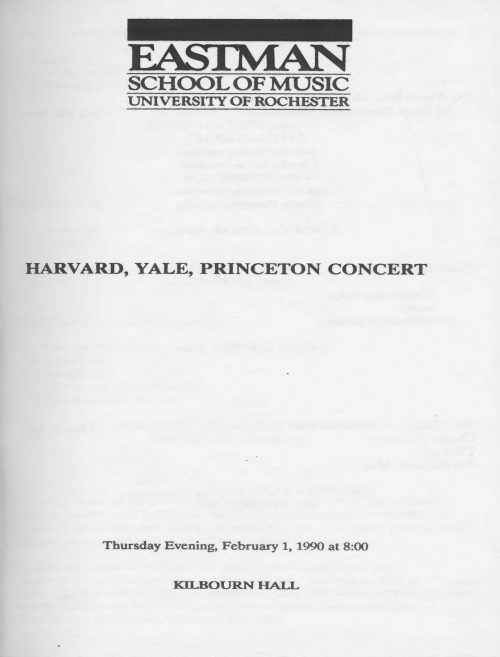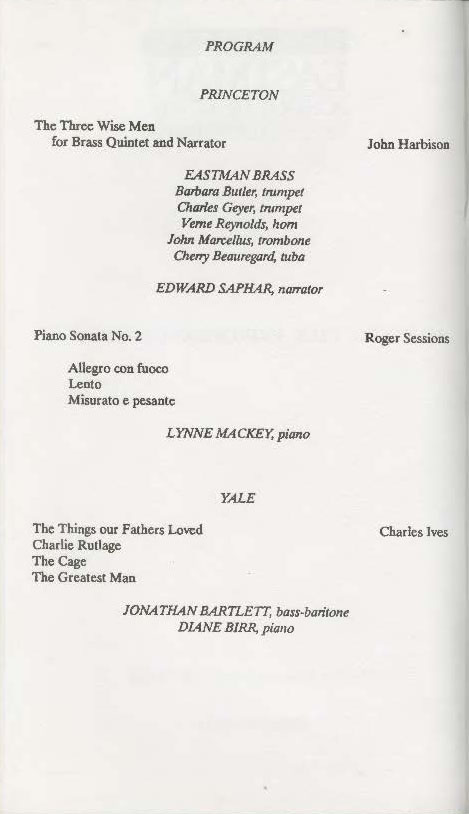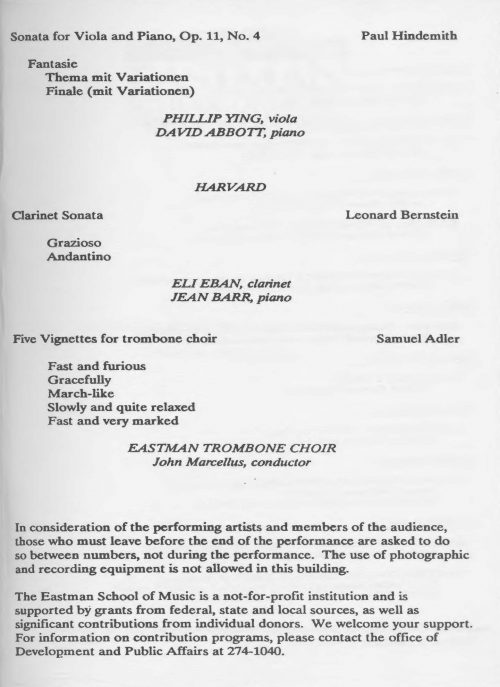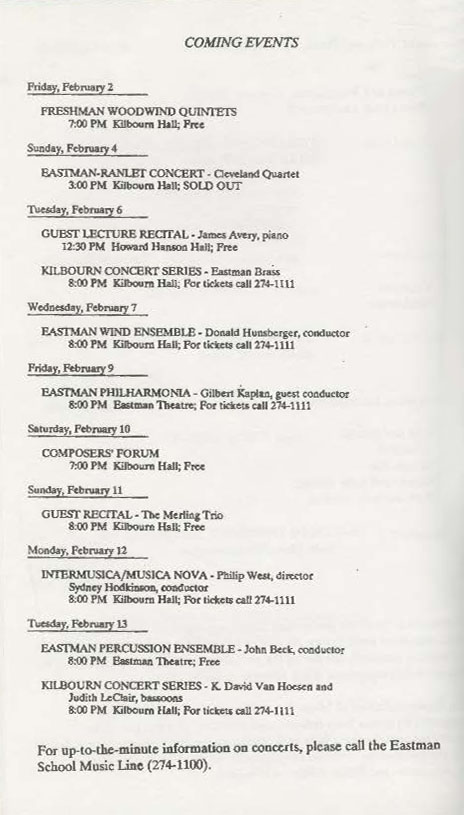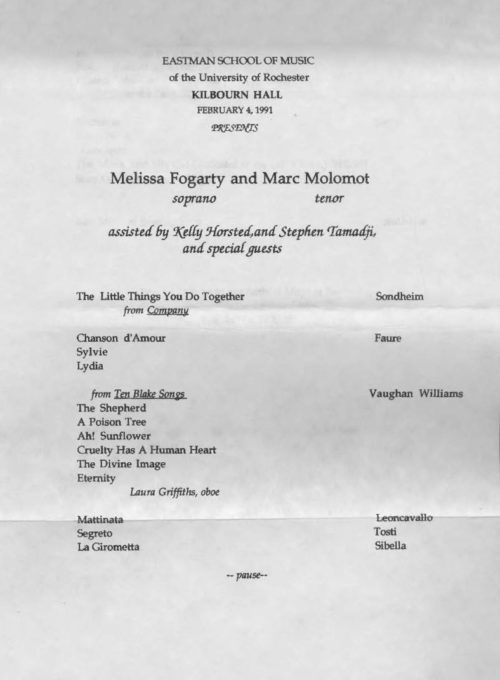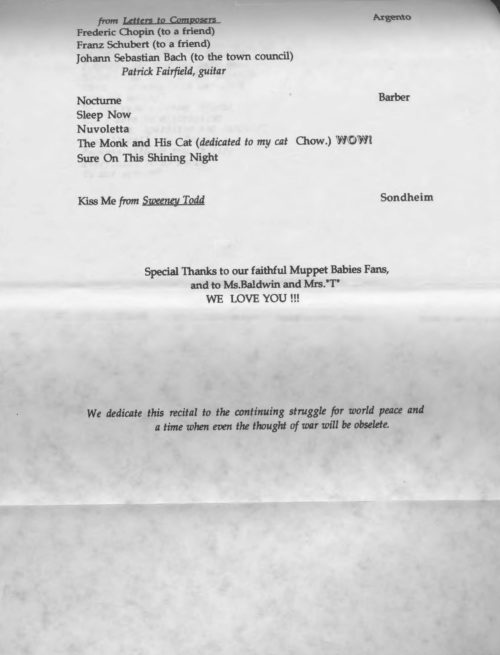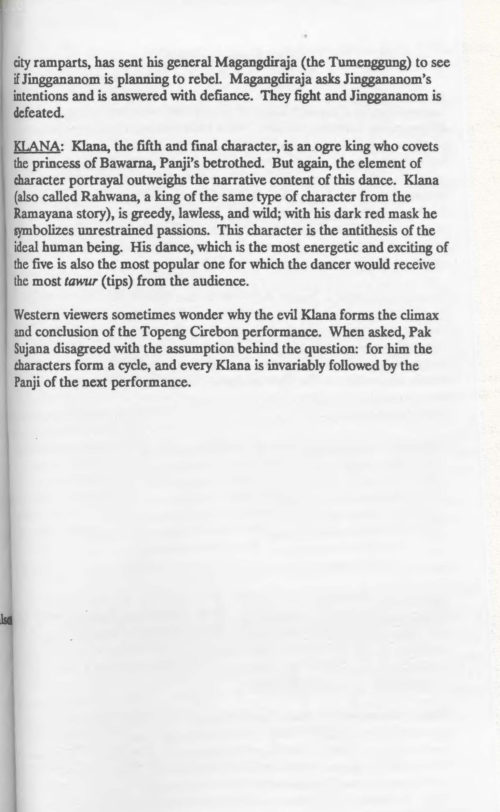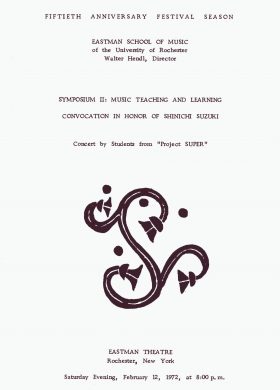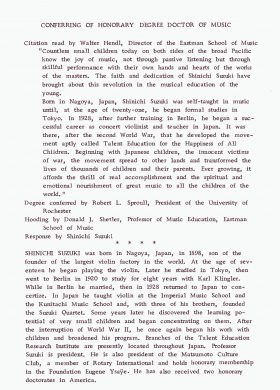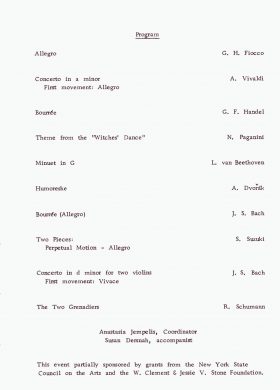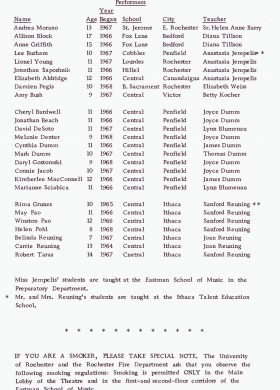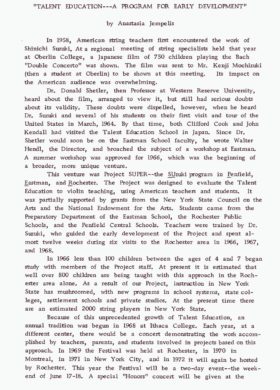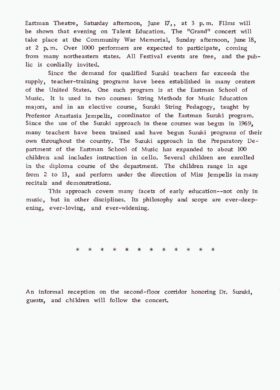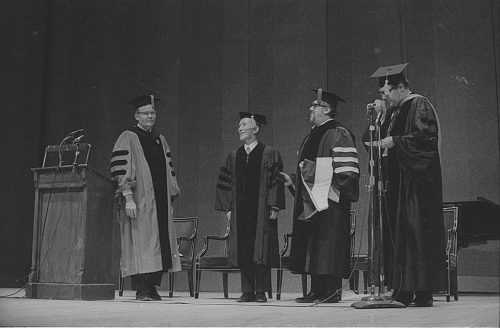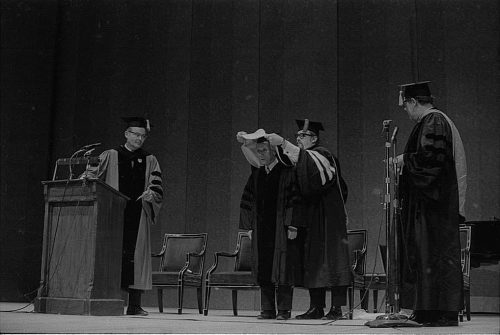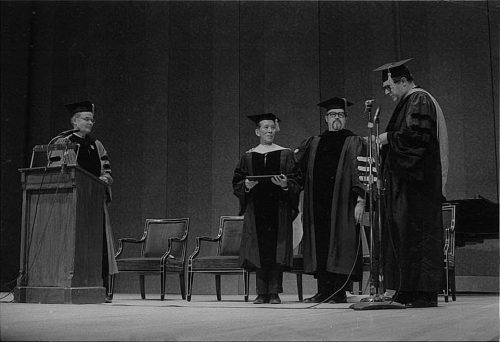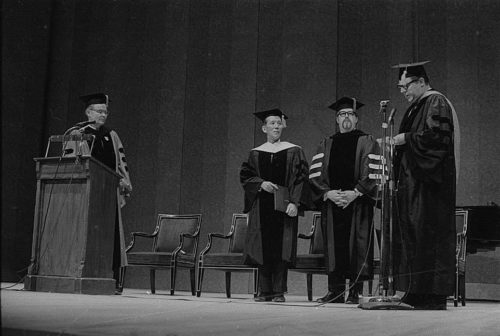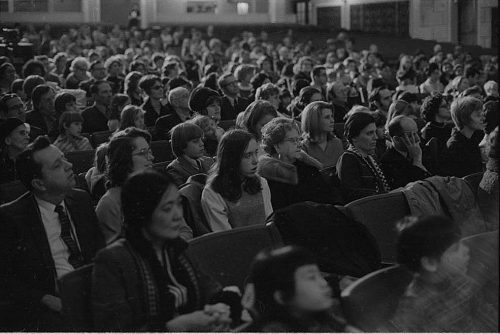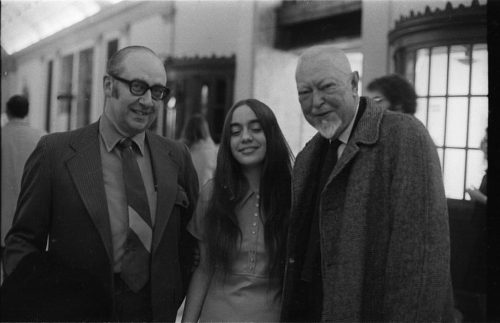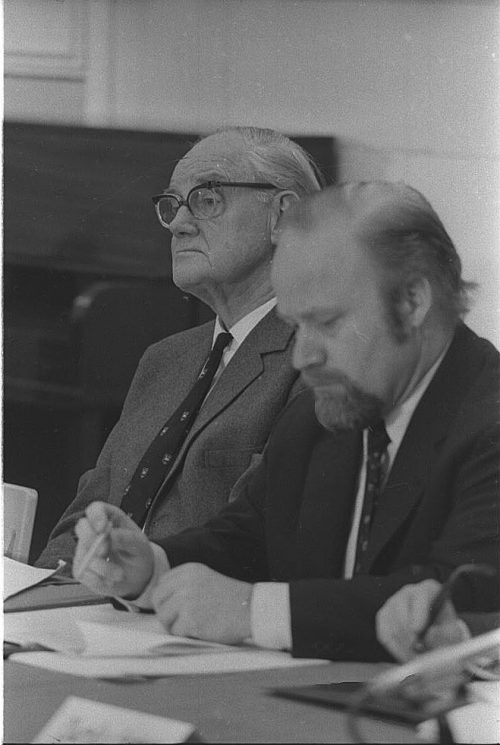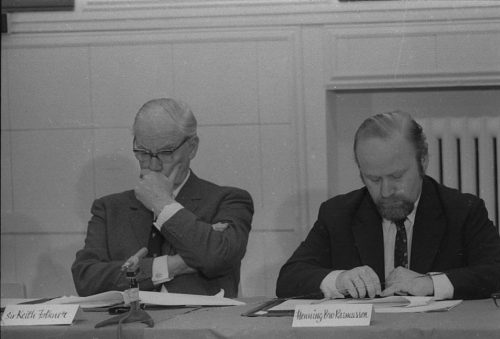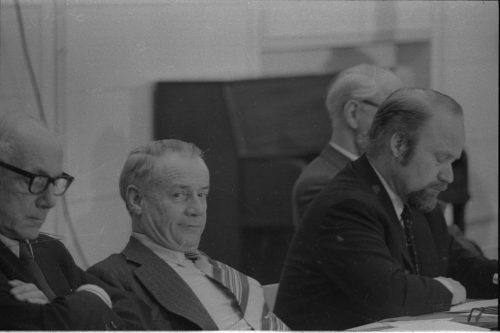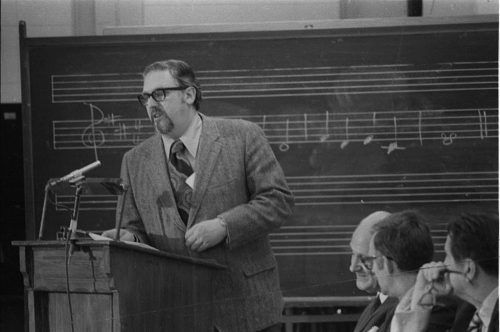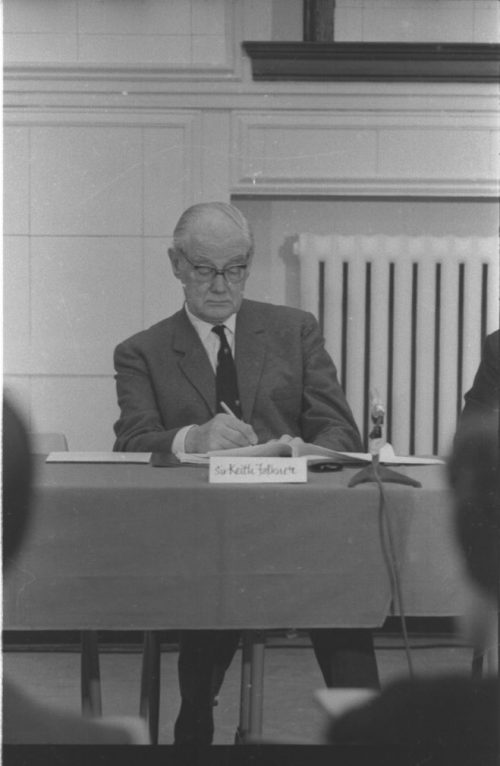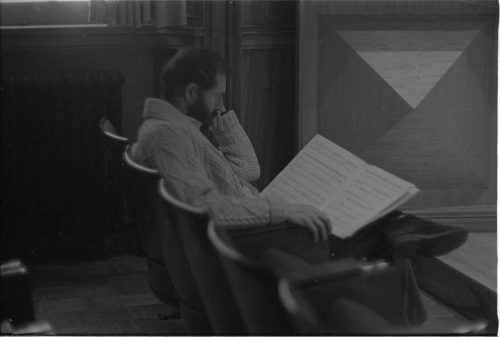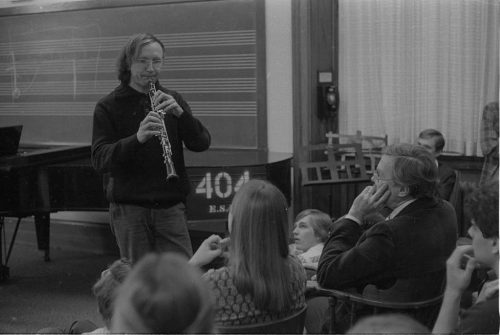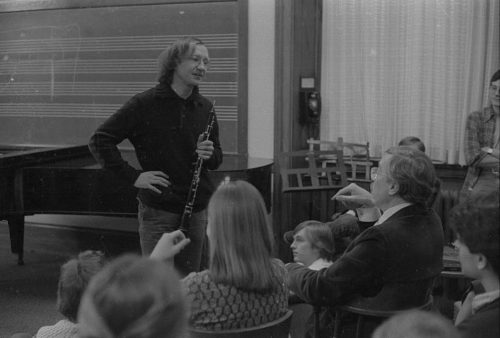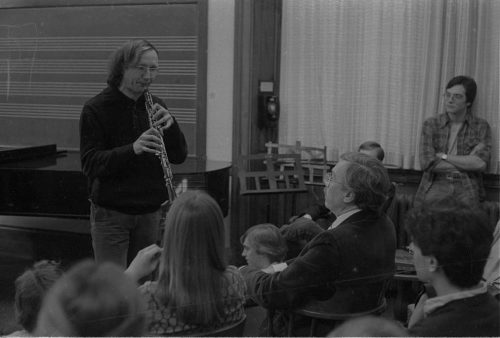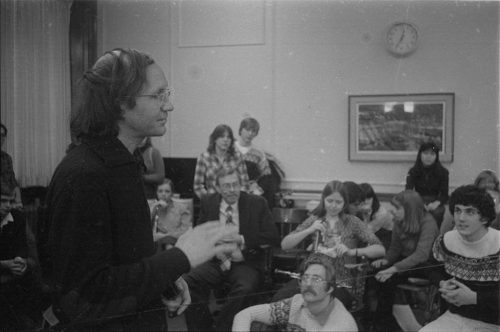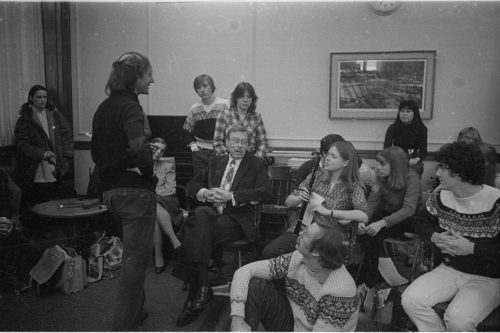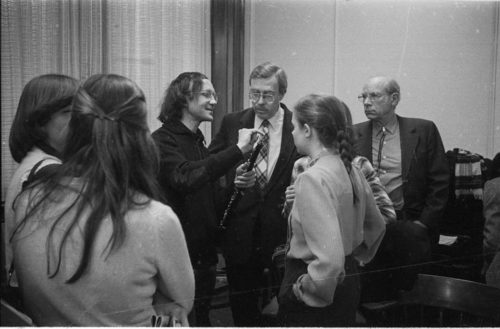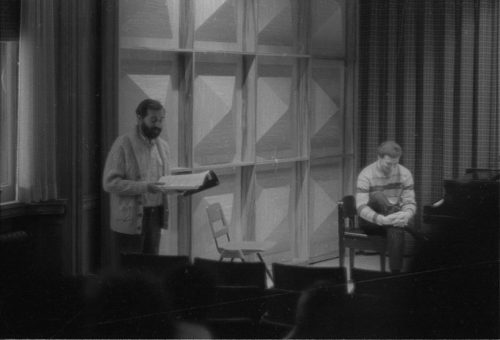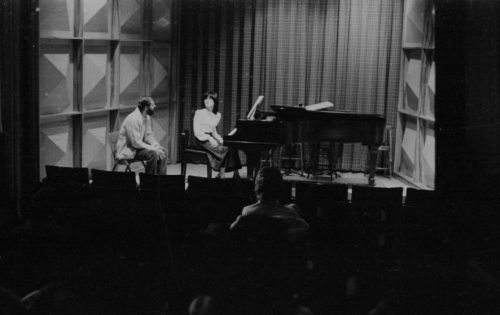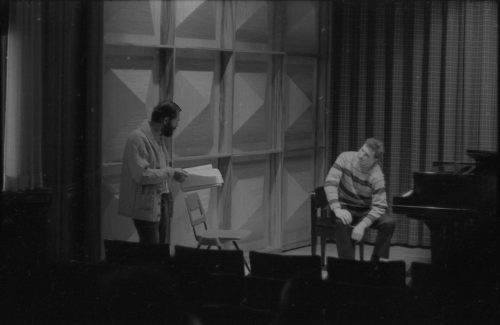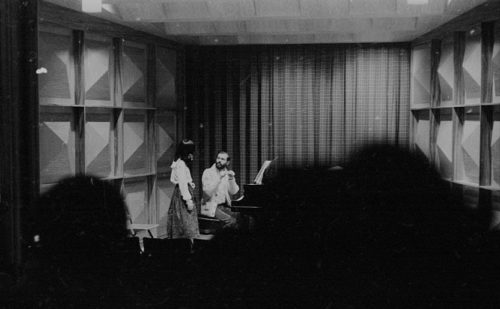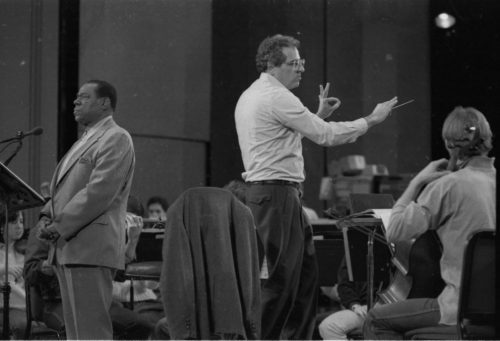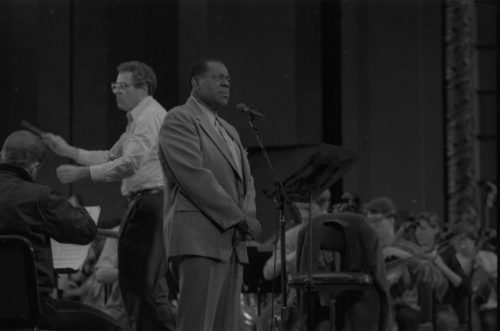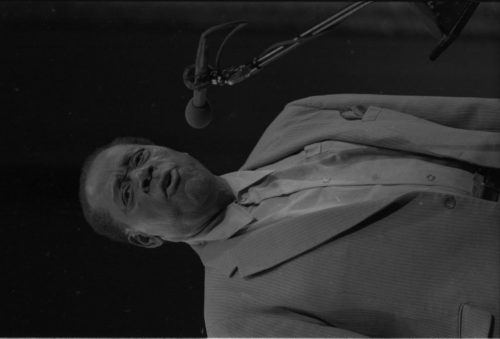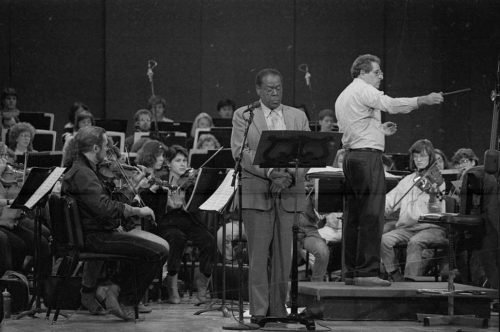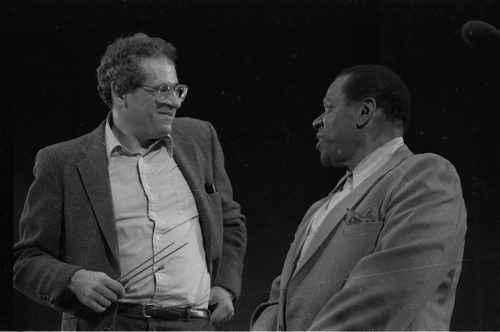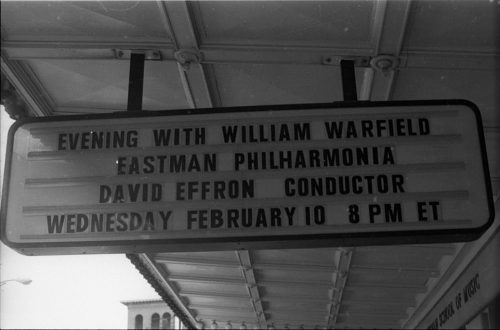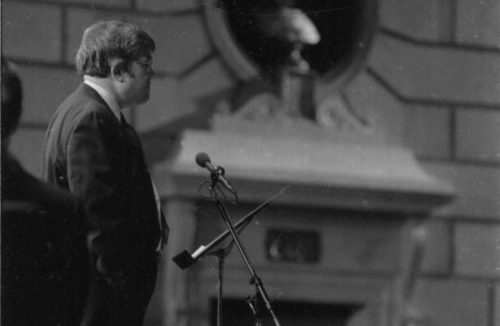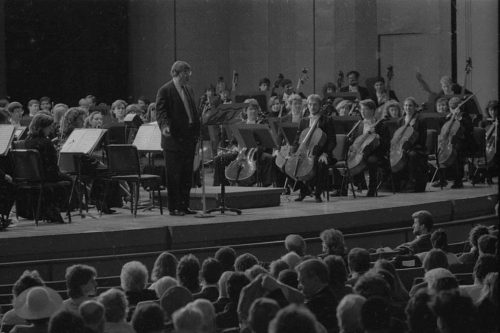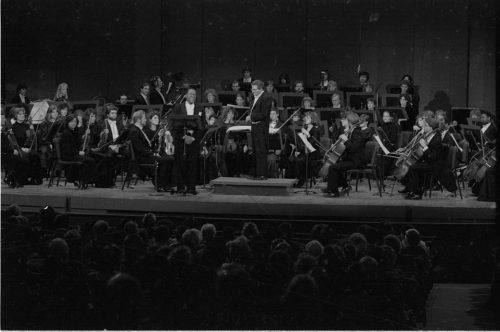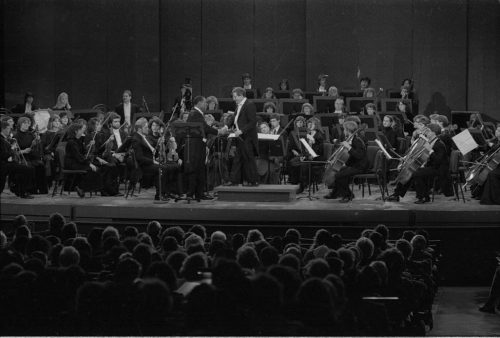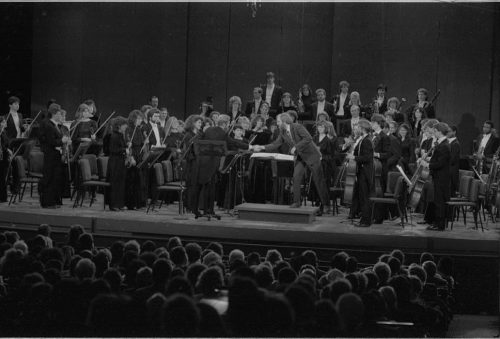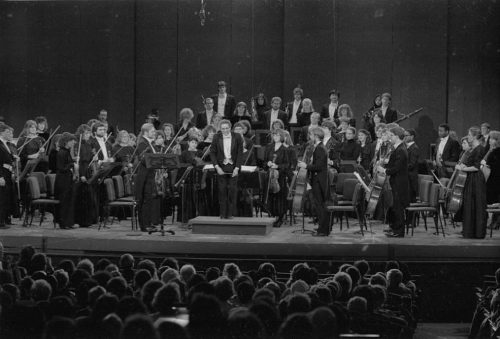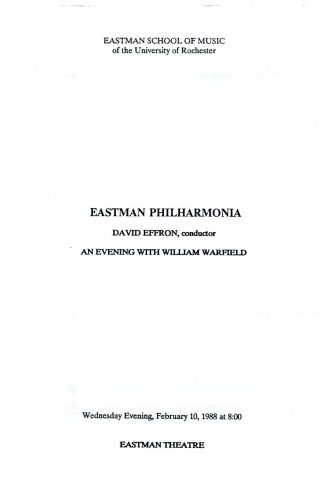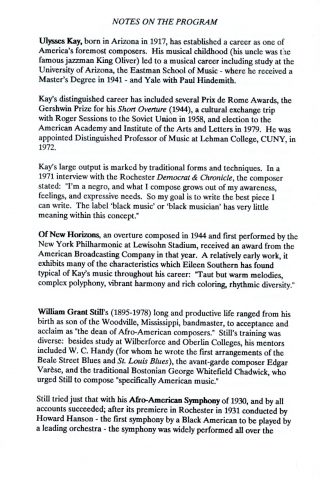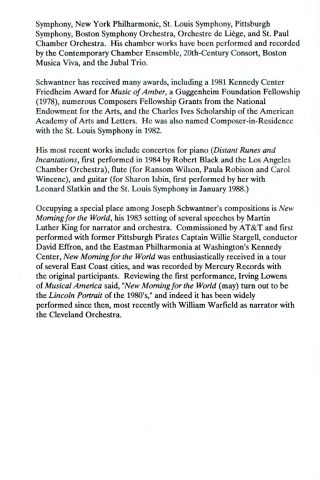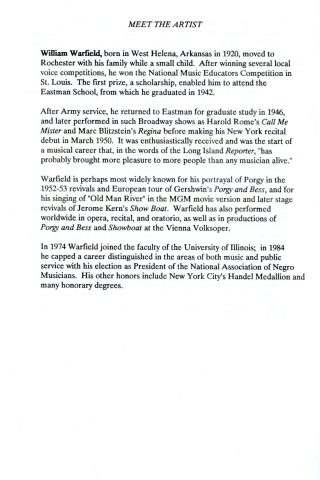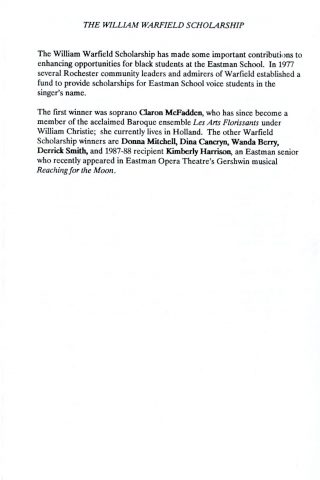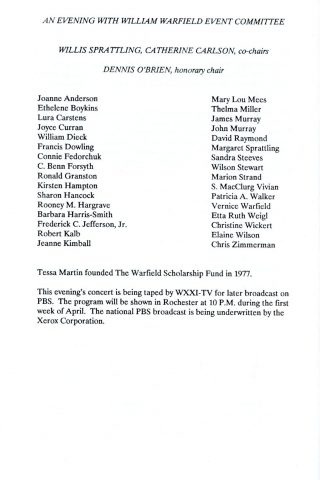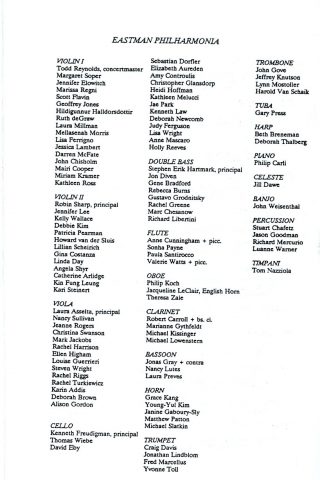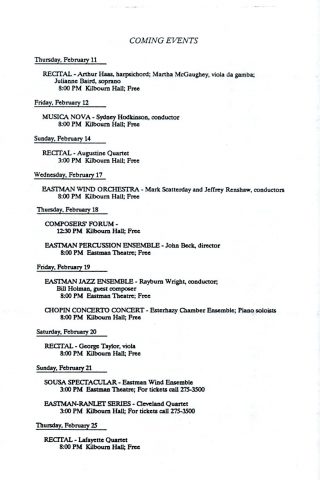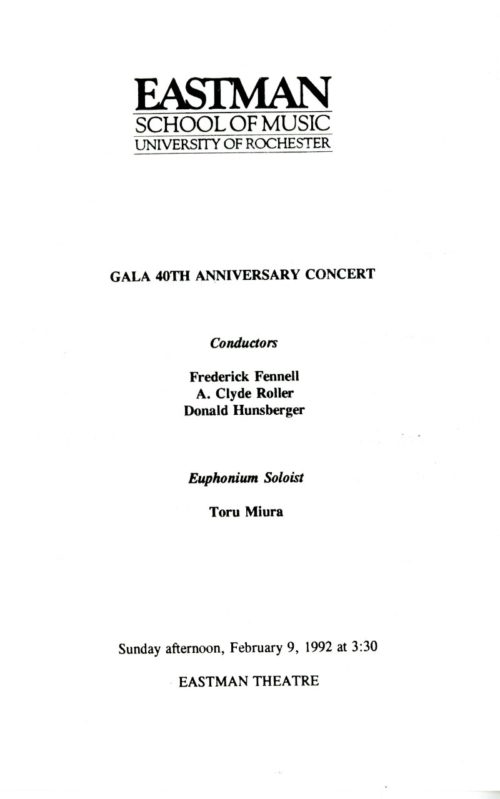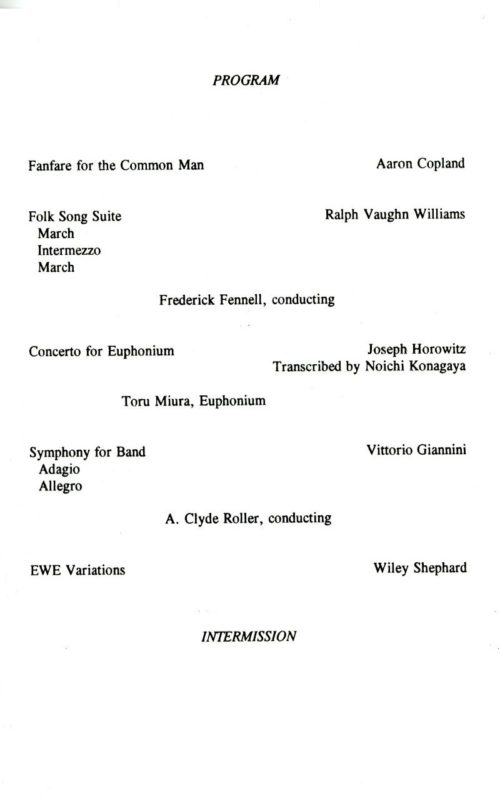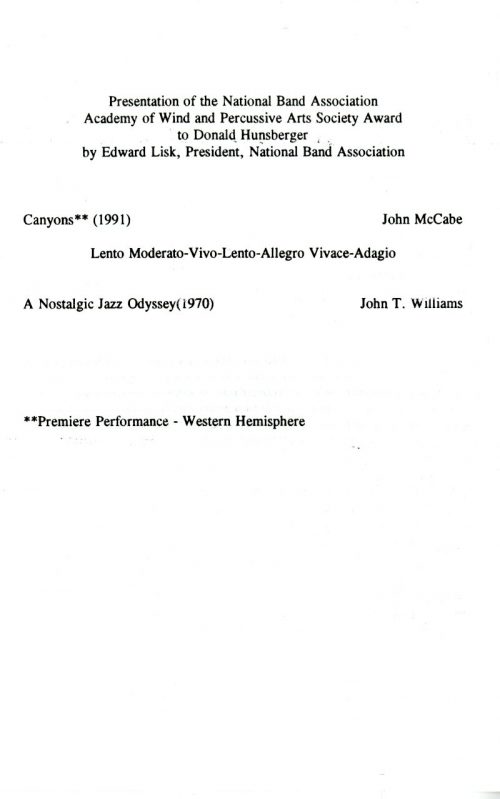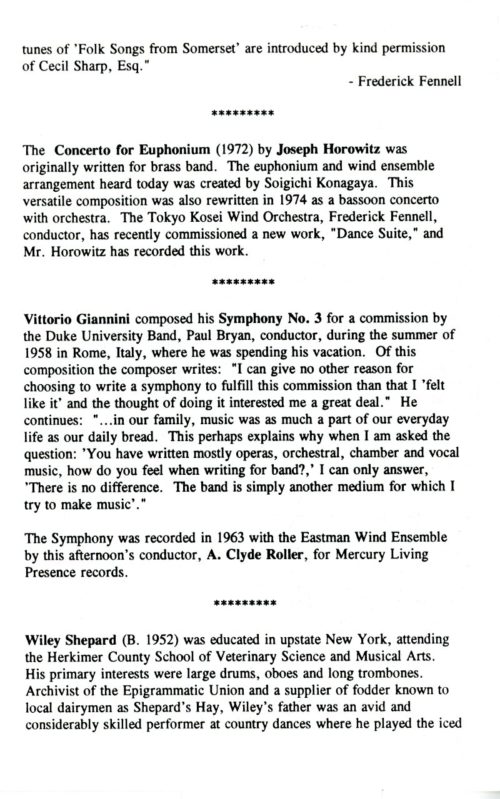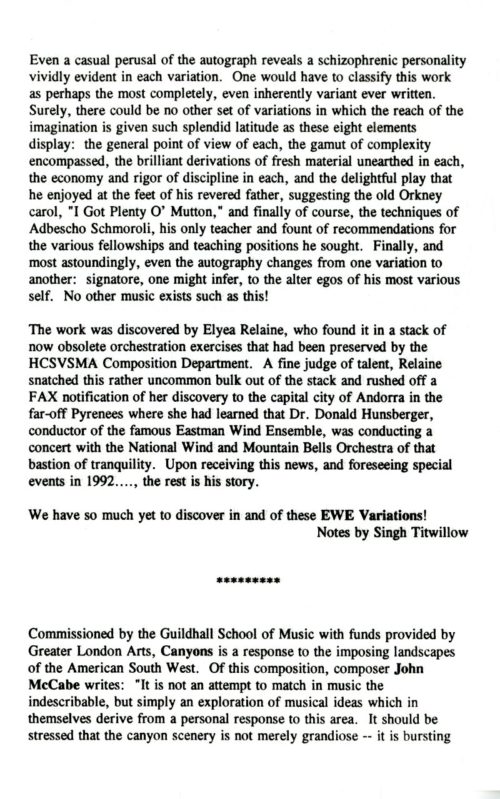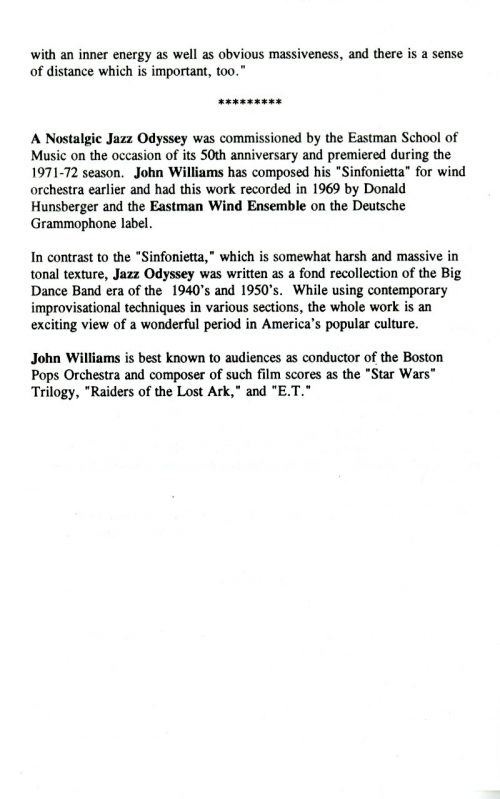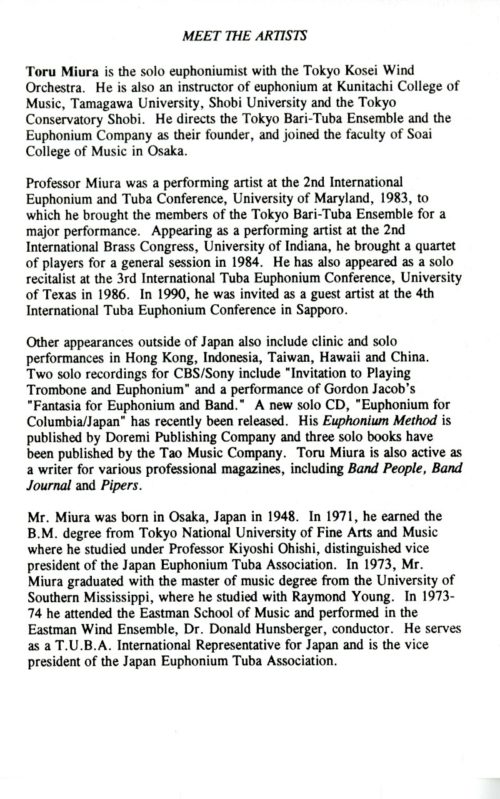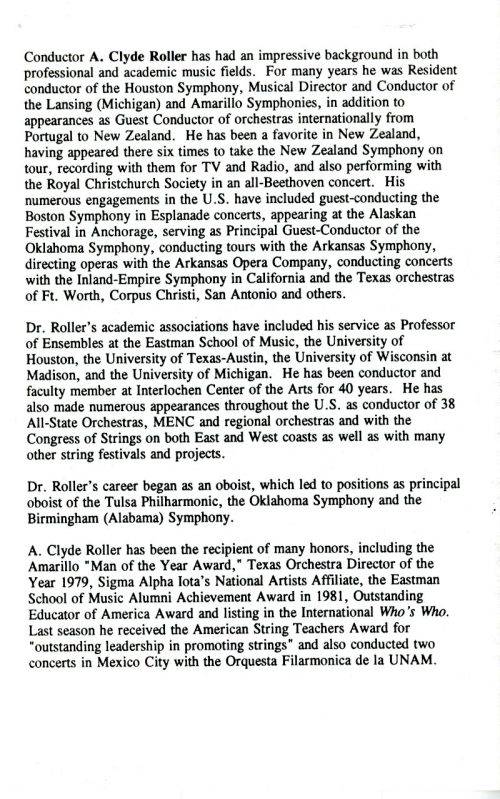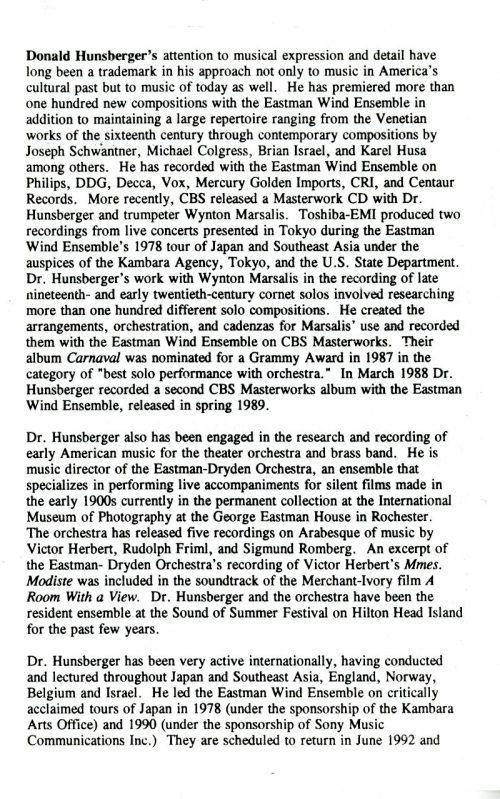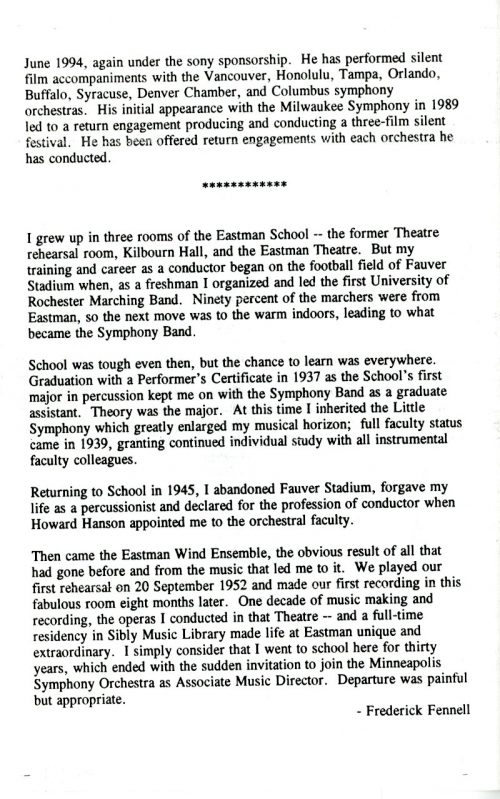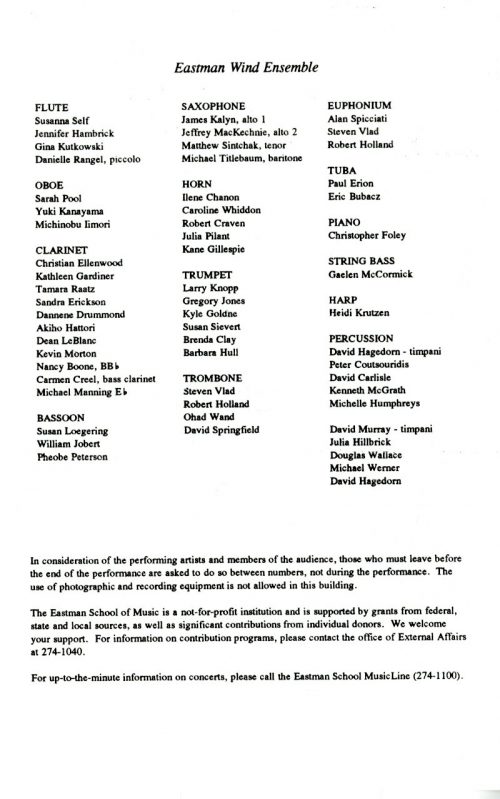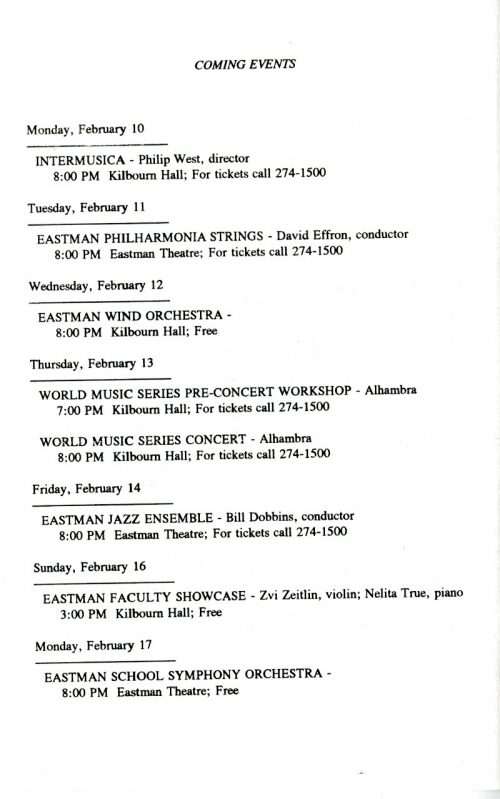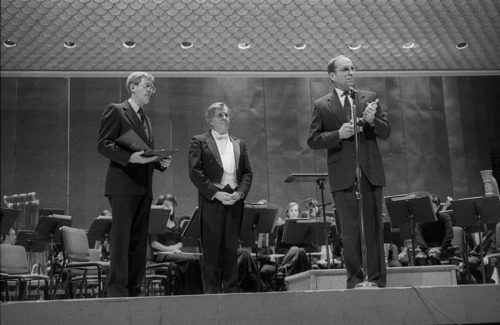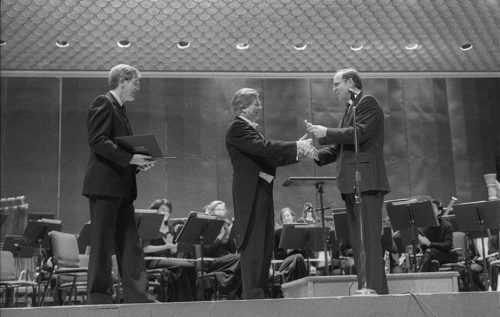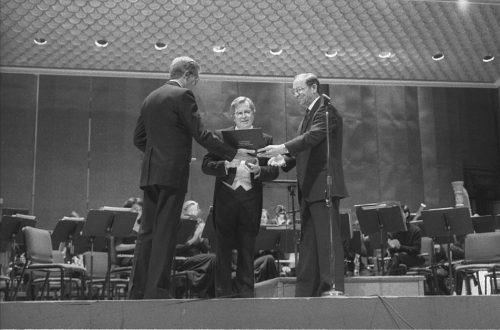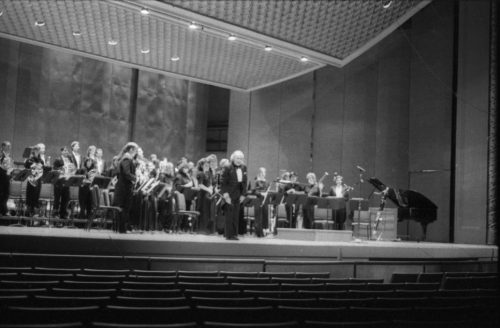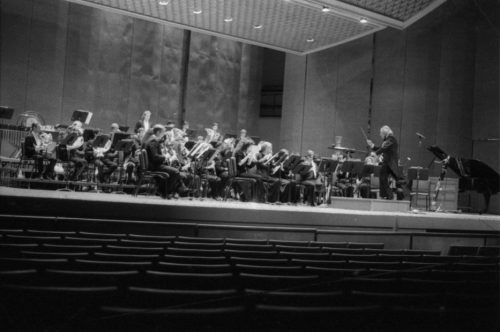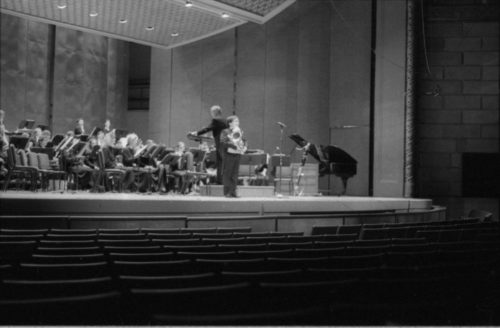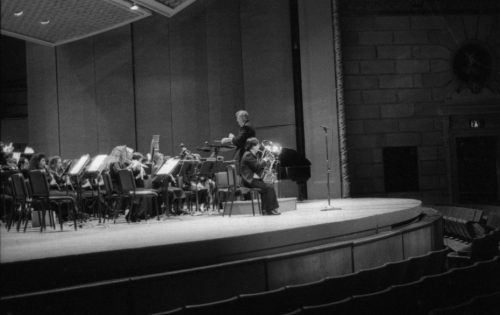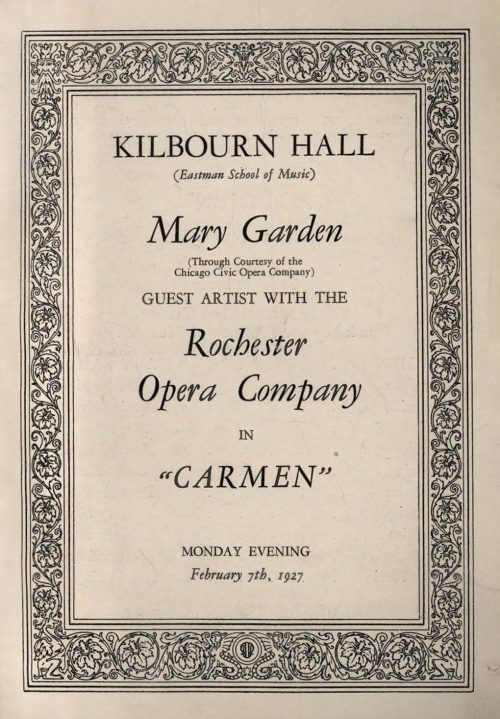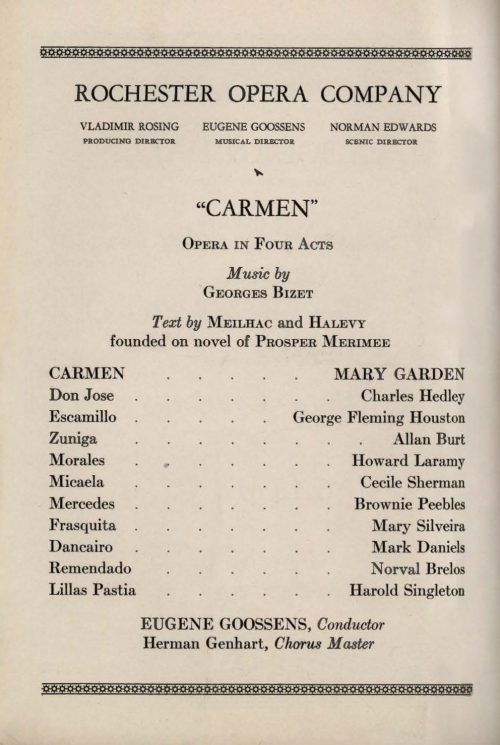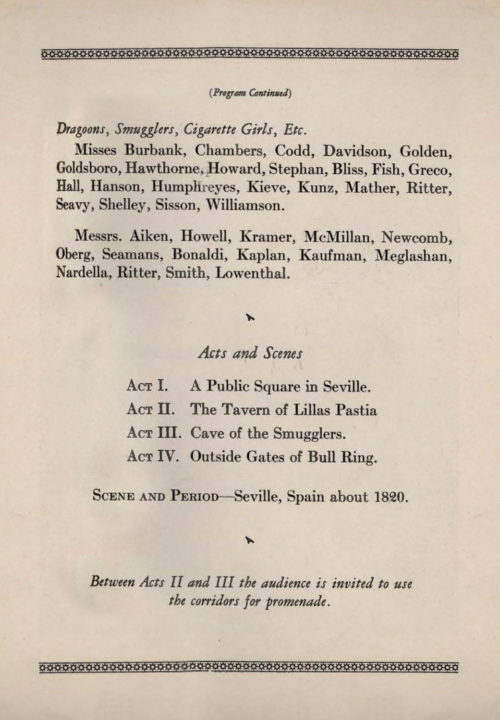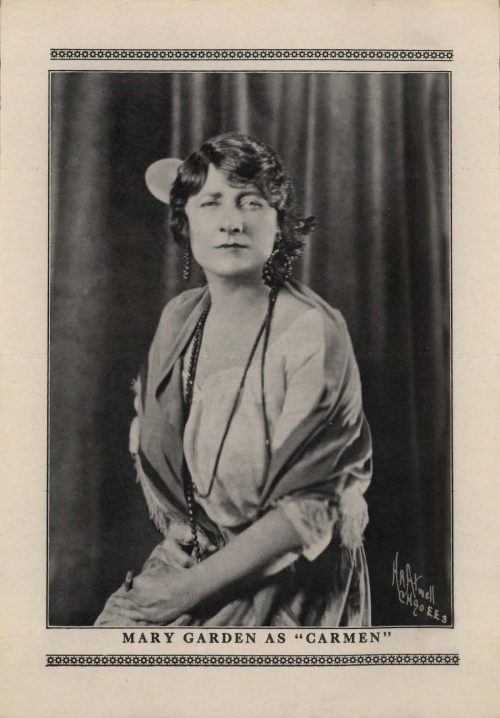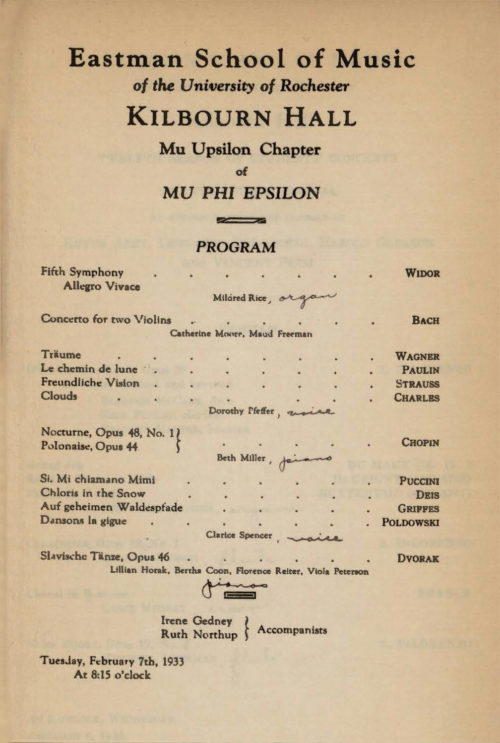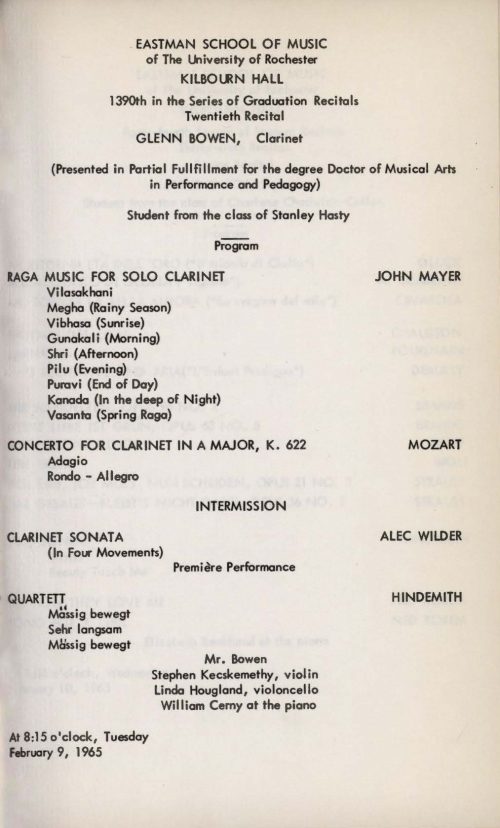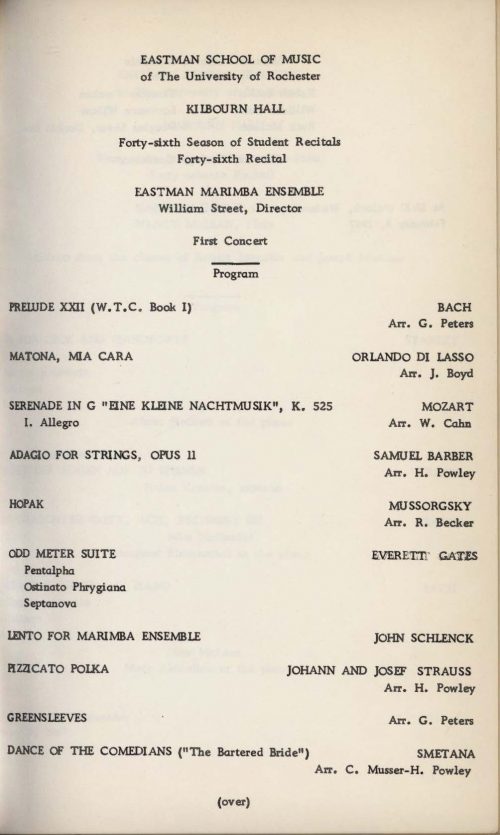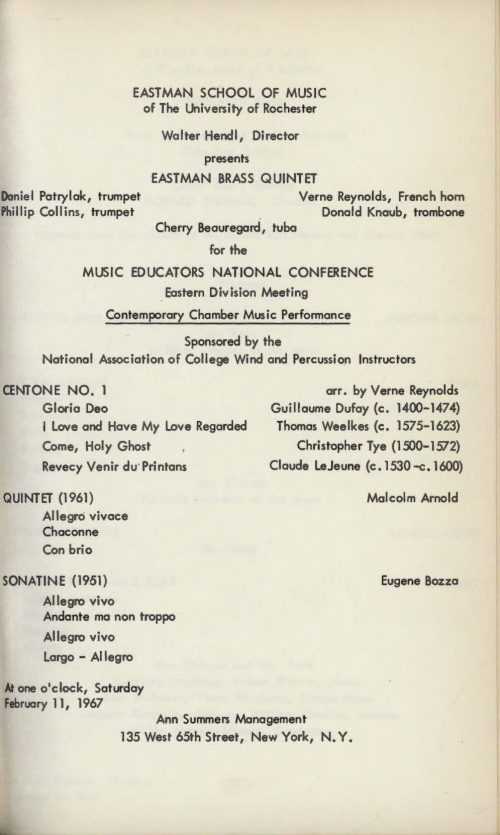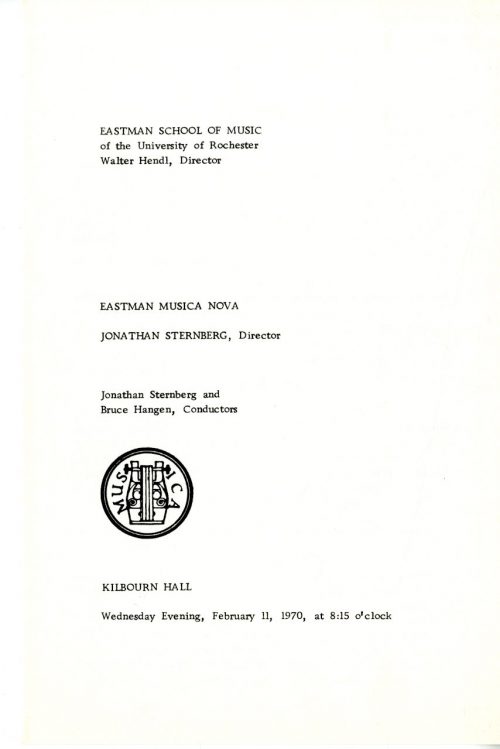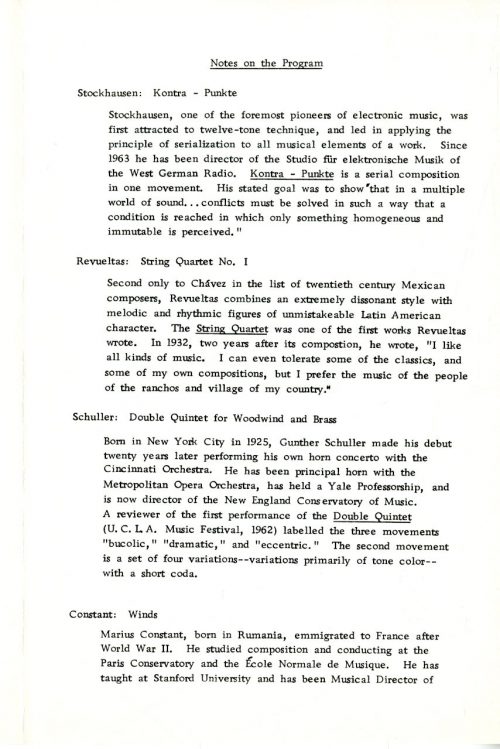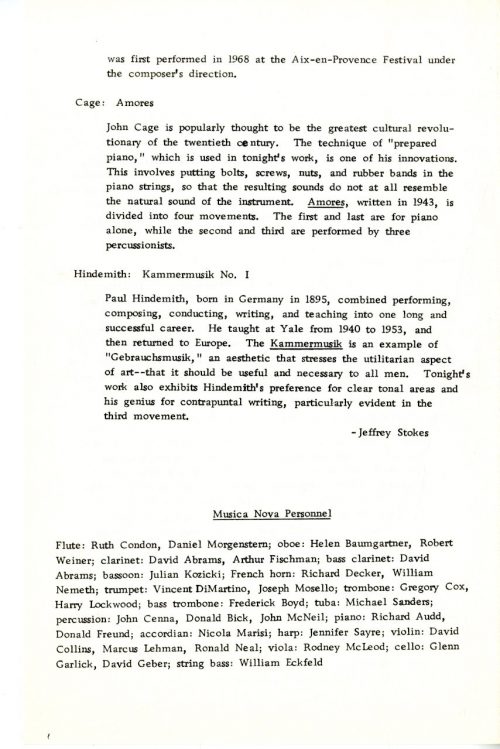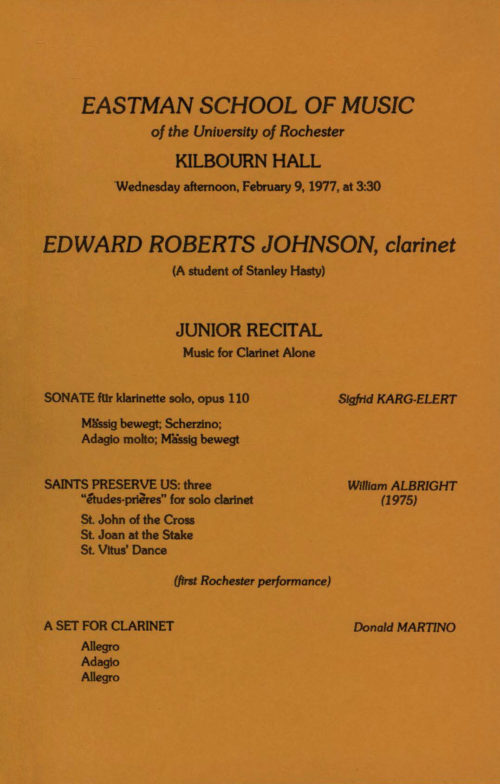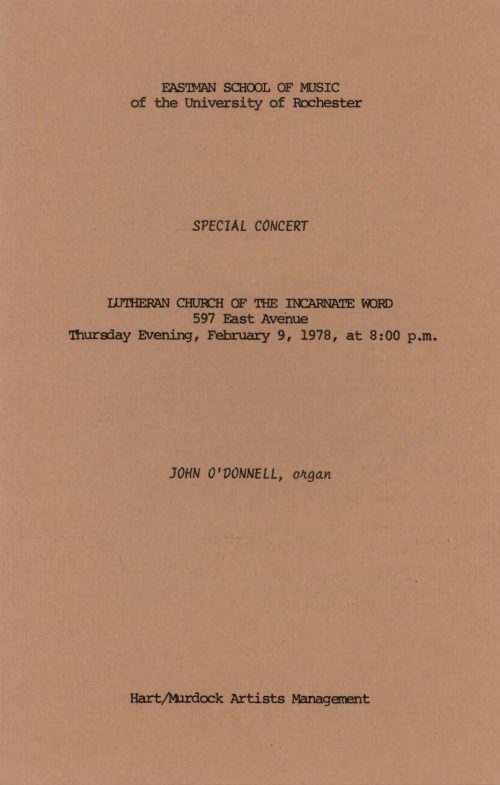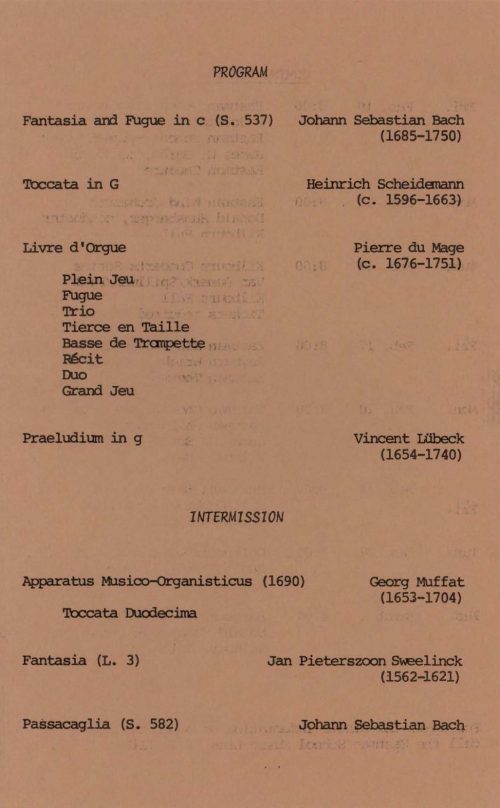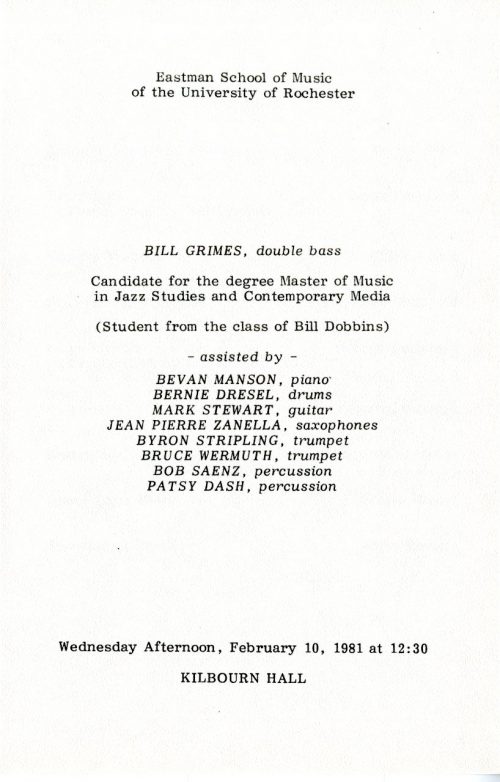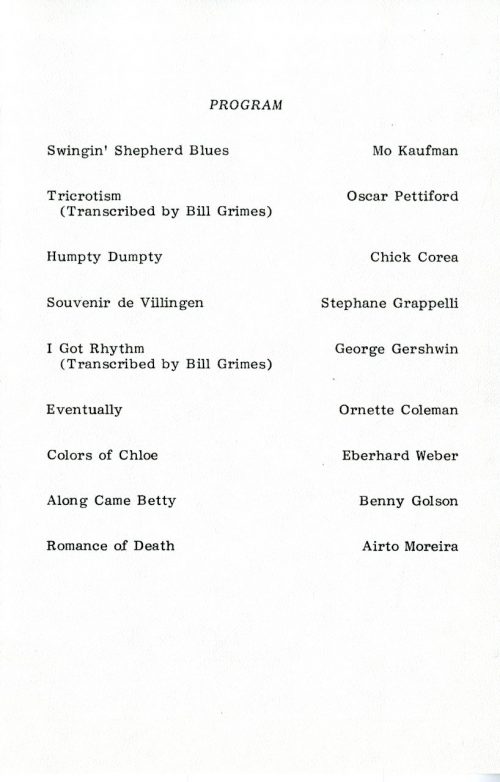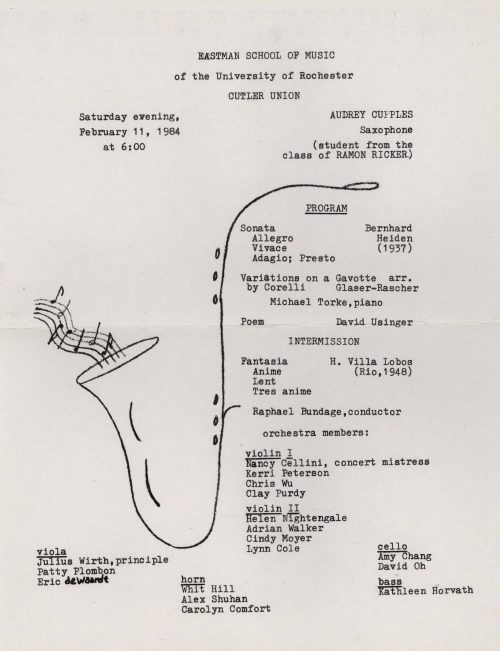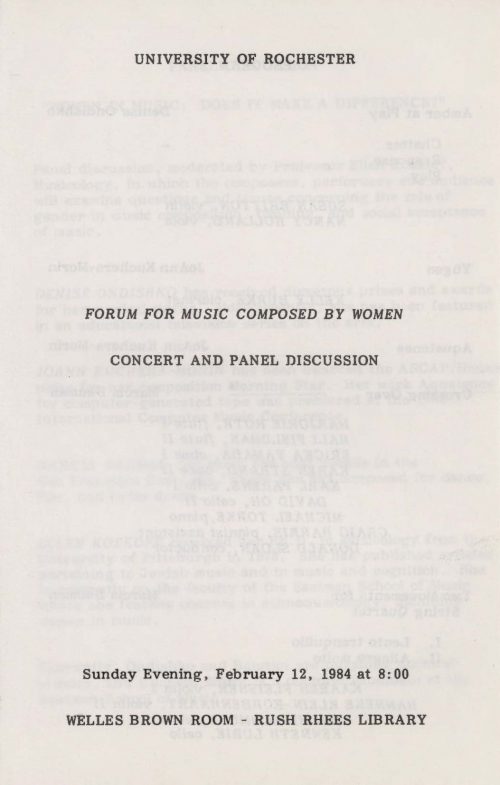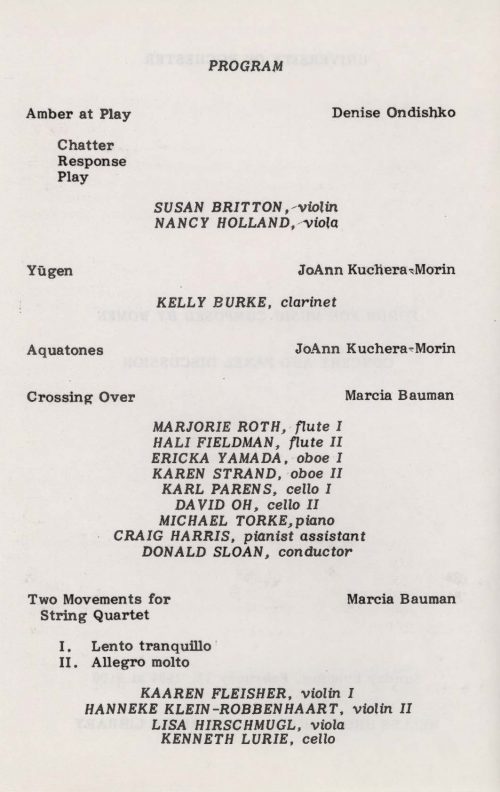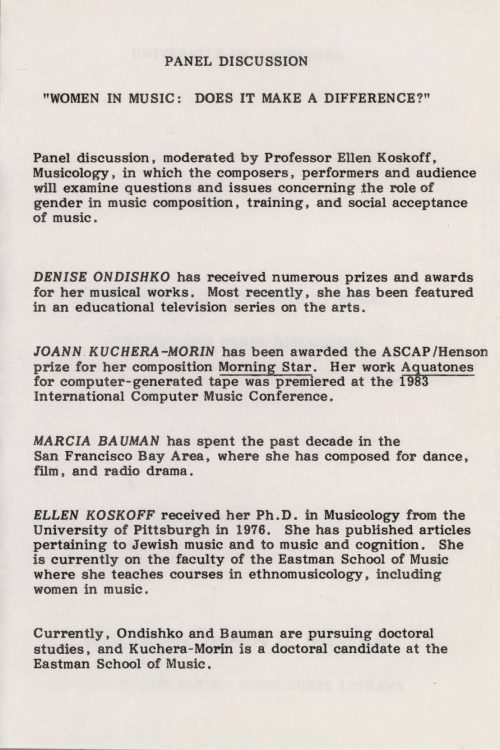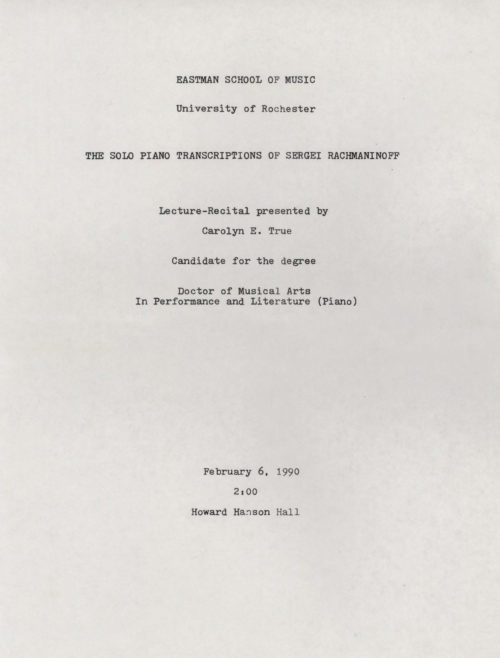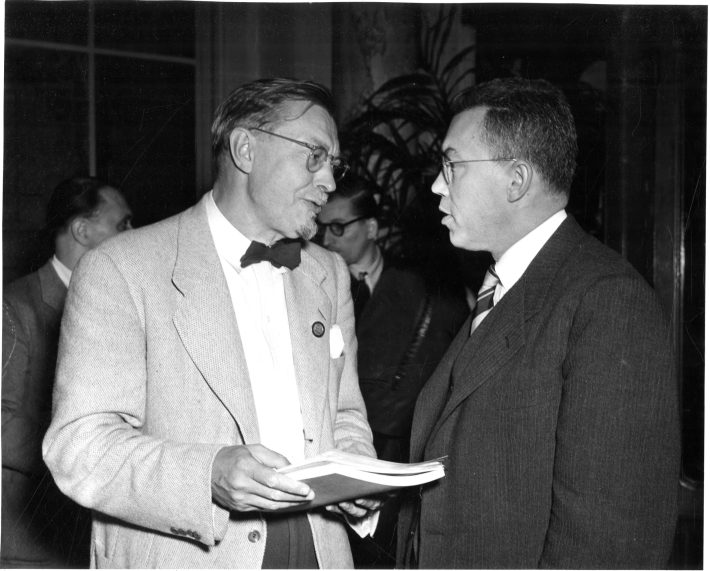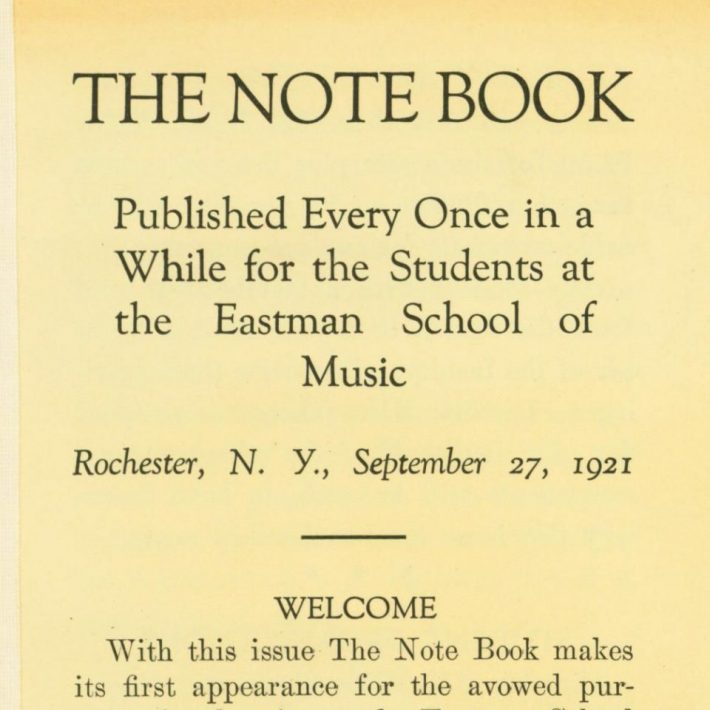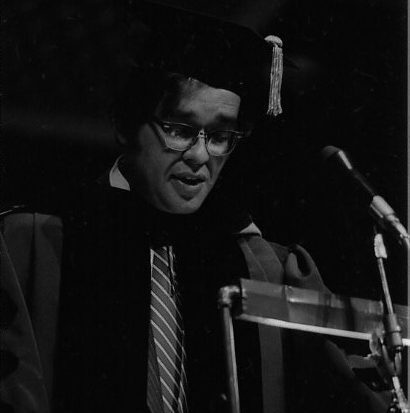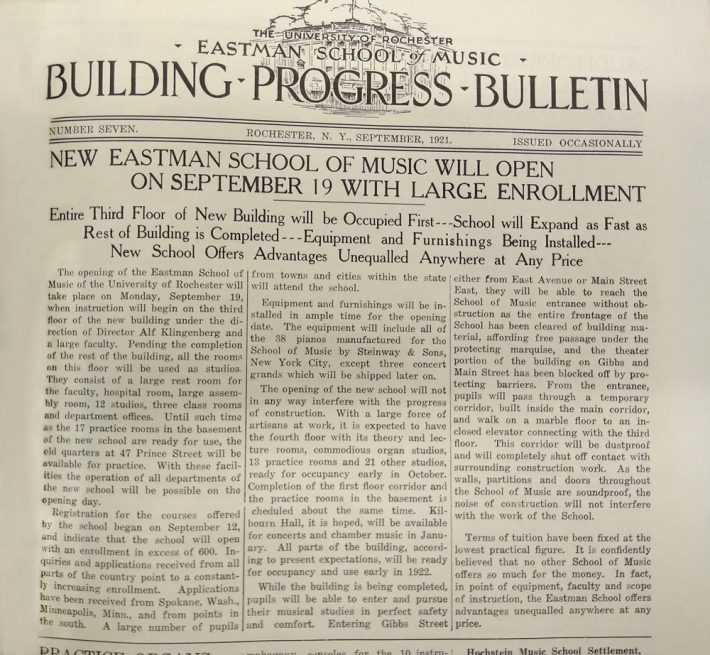1953: Eastman Wind Ensemble debut concert
Sixty-nine years ago this week, the Eastman Wind Ensemble made its public debut with a Sunday afternoon concert in Kilbourn Hall. It is surely no exaggeration to say that the concert on February 8th, 1953 marked not only one of the Eastman School’s milestones, but also the start of a new era. The concert not only gave exposure to a newly founded ensemble, but also promoted the concept of the wind ensemble which would, over the course of the next several decades, be enthusiastically embraced both at home in the U.S. and abroad.
No photographic coverage of the debut concert is extant; we only have the printed program, the master audio tapes, and two local press reviews. The master tapes have been digitally re-formatted more than once, ensuring the content’s continuing life. The news coverage of the event was purely local, for no reviewers from out of town were present; unlike the Eastman School’s annual springtime Festival of American Music, when Olin Downes, the chief music of The New York Times, and other reviewers made annual visits to cover performances in Rochester, the Eastman School’s regular programming during the academic semester was covered only by the local music writers for both of Rochester’s daily newspapers. Nevertheless, the fact of the debut was underscored by the announcement of same on the printed program, and by Maestro Fennell’s message of welcome which similarly appeared in the program. (His closing paragraph, expressing his hope that the new EWE would provide “pleasure and stimulation for the people of Rochester for many years to come,” might now be seen as altogether modest. Within just a few months, the EWE’s first commercial recording on the Mercury Records label would be heard on hi-fi sets in the nation’s living rooms, thereby launching the EWE on its tremendous public success. Altogether, the Eastman Wind Ensemble enjoyed a fruitful relationship with Mercury Records, producing 25 separate recordings between May, 1953 and May, 1962. Those recordings represented the most up-to-date recording technology commercially available at that time. The recordings were marketed both domestically and abroad, enhancing and cementing the EWE’s reputation in Europe and in Asia.
Frederick Fennell’s interest in bands had been a lifelong thing, going back to his days a high school camper at the National Music Camp (Interlochen, Michigan) and his having been high school drum major in the John Adams High School marching band in his native Cleveland. As an Eastman undergraduate he wrote to one of his mentors, the legendary band director Albert Austin Hardin (1880-1958), “I am all for bands and that is where I intend to do my work.” (The letter is in the Albert Austin Hardin Papers at the University of Illinois; the Ruth T. Watanabe Special Collections holds a photocopy of same.) After receiving his masters degree at the Eastman School in 1939, Fennell was appointed to the Eastman faculty as a conductor. With the exception of wartime service (1943-45) as National USO Music Advisor, during which time he was stationed in San Diego, California, he would continue throughout the ensuing years to direct the Eastman School Little Symphony, the Eastman School Junior Symphony Orchestra, and the Eastman School Symphony Band. His concern for the status of band music continued to increase throughout the 1940s, particularly whenever he was confronted with that age-old question “Who needs that big old symphony band?”. In 1950 Fennell won the Eastman School’s backing to organize the Kilbourn Hall Wind/Brass Program, a program under which he regularly rehearsed the Eastman School’s reed, brass, and percussion performers in repertoire tracing the development of wind literature. Eventually this program resulted in a concert performance which included the Rochester premiere of Stravinsky’s Symphonies of Wind Instruments. The success of that concert performance further prompted Fennell towards full formulation of his plan for the Eastman Wind Ensemble.
And so Frederick Fennell organized the Eastman Wind Ensemble in September, 1952 so as to meet what he perceived as the need for an ensemble of virtuoso caliber possessing the forces necessary to perform every type of music written for winds. His intention was to keep the instrumental forces as simple as possible; to that end, the ensemble would utilize no more than 45 players at its maximum. The resulting wind-brass-percussion corps would permit an almost limitless number of combinations of the three constituent groups in both large and small instrumentations. As Fennell pointed out in Time and the Winds (Kenosha, Wis.: Leblanc, 1954), the Wind Ensemble’s instrumentation would constitute the same orchestra for which Wagner scored Der Ring des Nibelungen, and which Wagner assembled at Bayreuth in 1876, together with a saxophone section and one alto clarinet, and minus one bass trumpet — the same wind section which Stravinsky used in 1911 for Le sacre du printemps. Such an instrumentation would permit the performance of all music written for wind instruments dating from the 16th century through to the present century. (By the way, you can read the original manuscript copy of Times and the Winds at the Ruth T. Watanabe Special Collections in the Sibley Music Library.)
The debut concert’s programming was representative in that old and new music for winds shared billing on one and the same concert program. The Mozart Serenade no. 10 was ideally balanced by the 20th-century works by Wallingford Riegger and by Paul Hindemith. Two of those works would be particularly significant for the EWE in the years immediately ahead; the Mozart and the Hindemith were both recorded for Mercury Records. Further, the presence of the new music went hand in hand with Maestro Fennell’s interest in seeing new music composed expressly for the wind ensemble. The Mozart Serenade would continue to be a “fight song” for Fennell the conductor and also the arranger; he later made his own performing edition of the Serenade no. 10, published by Ludwig Music (c1993).
Frederick Fennell later recounted the founding of the Eastman Wind Ensemble and also the story of the Mercury Records recordings for author Roger Rickson, a California-based music educator and bandleader who was a staunch Fennell supporter and admirer. Mr. Rickson’s book Ffortissimo: a bio-discogrqphy of Frederick Fennell: the first forty years, 1953 to 1993 (Ludwig Music Publishing, c1993) is an essential source for all who are interested in this musical development. The Roger Rickson Collection at the Ruth T. Watanabe Special Collections is a valuable collection of all of the EWE recordings on the Mercury label, bringing together in one source each of the monaural and stereo issues, and also accounting for each album’s variant record jacket printings wherever such occurred. Further, Maestro Fennell’s written account is preserved in his 1954 manuscript Time and the winds; a short history of the use of wind instruments: Background for the wind ensemble, which resides in the RTWSC vault.
The programming of the first concert was truly representative in that old and new shared billing on one and the same concert program. The Mozart Serenade was balanced by the 20th-century work by Wallingford Riegger and by Paul Hindemith. Two of those works would be particularly significant for the EWE in the years immediately ahead; the Mozart and the Hindemith were both recorded for Mercury Records. Maestro Fennell later made his own performing edition of the Mozart Serenade no. 10, published by Ludwig Music Publishing in 1993.
All the rest is history. As the decades have passed, the Eastman Wind Ensemble has flourished under the direction of Dr. Donald Hunsberger and Dr. Mark Scatterday. The EWE has continued to record and has gone on numerous tours, both domestically and internationally. (In particular, the 14-year period 1990-2014 saw a Southeast Asian tour every other summer.) The EWE has continued to represent the vanguard in concert programming for winds. That has been no small legacy stemming from a Sunday afternoon recital in February, 1953.
1962: The continuing story of the Eastman Philharmonia on tour
We continue the story of the Eastman Philharmonia on their landmark three-month tour of Europe, the Middle East, and the Soviet Union. Sixty years ago this week, the days of February 7th through 13th found the orchestra members on the territory of what is today the independent republic of Ukraine. On February 7th the orchestra members were in Chernovtsi (today Chernivtsi) and the next day travelled by train to Lvov (today Lviv). On February 12th the group departed by night train for the overnight trip to Kiev (today Kyiv). In that stretch of time the orchestra played concerts in Chernovtsi (February 6th and 7th) and in Lvov (February 10th and 11th). The printed program for the latter is displayed here; the program for the Chernovtsi concerts is displayed in last week’s entry.
Bassoonist Richard Rodean, BM ’62, MM ’64, keeper of a lively travel journal that is archived in the Eastman School of Music Archives, continued his mission of meeting with bassoonists as frequently as he could. In Lvov, Dr. Hanson called a rehearsal that was attended by students of the city’s conservatory. After the rehearsal had concluded, Mr. Rodean met with the conservatory’s bassoon instructor and his students; Mr. Rodean and the instructor conversed in German, which the instructor then translated into Russian for his students. Mr. Rodean’s journal continually records his specific observations of the bassoons that he encountered abroad and how meaningful it was for him to share instrument-specific lore and expertise with international musicians whom he met during the tour. His enjoyment of concerts and other cultural activities is likewise tremendous. On February, having just arrived in Kiev, Mr. Rodean managed to acquire for one ruble a ticket to a concert on the following evening of the Leningrad Philharmonia Orchestra, which was just then performing on tour in Kiev. The soloist would be the renowned violoncellist Mstislav Rostropovich.
As I’ve previously commented, Mr. Rodean eventually wrote of his perception that the orchestra members were beginning to show signs of strain and fatigue after being so long on the road. He described how during their time in Chernovtsi, members of the orchestra one morning built a huge snowman in front of the city’s university. Later that same day some of the musicians visited a municipal park and erupted into a huge snowball fight, which drew a large crowd of spectators in no time. I’m inclined to think that those pursuits were a healthy and constructive way to work out tensions! Altogether, such details as Mr. Rodean recounts on page after page bring life to the story of the tour by offering vignettes of everyday life and human interest. Perhaps inevitably, the enforced focus on a conductor contributed in time to orchestra members noticing and commenting upon that individual’s foibles, such as when Dr. Hanson had run out of cigars and associate conductor Fennell appealed to the smokers in the orchestra to donate a cigar or two “to the cause”. During the time in Lvov, Mr. Rodean recounted that on one evening when the orchestra’s Intourist hotel threw a dinner party for them, Dr. Hanson sat down at the piano and played strains from his own “Nordic” and “Romantic” Symphonies. It seems not unfair to observe that wherever Howard Hanson found himself in the world, his inclination towards self-promotion never departed.
The Philharmonia members would spent four full days in Kiev. Next stop: Leningrad.
1972: Premiere performance of Perendecki’s Partita during the 50th Anniversary
Conductor Walter Hendl, composer Krystof Penderecki, and soloist Felicja Blumental conferring over the score in the Eastman Theater. Ms. Blumental’s husband Markus Mizne is seen in the background in several of these shots.
► Photos by Louis Ouzer. R1393-19, R1393-20, R1393-23, R1393-24, R1393-25, R1393-26.
Fifty years ago this week, on February 11th, 1972, the Eastman Philharmonia premiered a new work by Krzysztof Penderecki (1933-202) in the Eastman Theater, arguably the highest-profile performance in the sequence of premiere performances that were delivered during the Eastman School’s 50th anniversary season. In this instance, the new composition was the Partita for Harpsichord and Orchestra which the composer had written for, and had dedicated to, Polish-born pianist and composer Felicja Blumental (1908-1991). ESM Director Walter Hendl conducted the Eastman Philharmonia, and four days later, on February 15th, the same forces performed the Partita again at Carnegie Hall in New York City, marking the second appearance by the Eastman Philharmonia in that august venue.
Mr. Penderecki was an invited guest to the Eastman Philharmonia performance, actually making a visit of several days to the Eastman School. During that time he was interviewed for the Rochester press, and two days before the performance, he visited at length with Eastman composition students in a scheduled afternoon session. The archival photographs by Louis Ouzer show Mr. Penderecki to have been an active participant in preparation of the Partita as he conferred with conductor Walter Hendl with earnest deliberation. It should be noted that Mr. Penderecki’s visit in 1972 would mark the first of three visits that he would make to the Eastman School; he would later return in 1987 and in 2004.
The Partita was published by Schott. It was first recorded on a 1973 LP featuring Miss Blumental as soloist with Mr. Penderecki as conductor; that recording won the Grand Prix du Disque for 1975. The master tapes of the Eastman Philharmonia’s premiere performance reside in the Eastman Audio Archive; they have been digitally transferred for enjoyment by the Eastman community. As it happened, the premiere performance received some salty words of criticism at the hands of the music critics of Rochester’s two daily newspapers, the Rochester Times-Union and the Rochester Democrat & Chronicle. It seems in decidedly bad form that small-town critics would train their fire on a new work by a composer of international standing, as well as on a performance by the exquisitely prepared senior orchestra of a conservatory of international repute. Nevertheless, notwithstanding the local critics’ disparaging comments, the commission of the Partita brought prestige to the Eastman School of Music, and the premiere performance was an acknowledged highlight of the 1971-72 Fiftieth Anniversary Season.
Herewith a curator’s footnote. I happened to observe not long after the composer’s passing that the autograph manuscript of the Partita had been put up for sale; as it happened, the price of asking surpassed the Sibley Music Library’s available means. In an earlier time, Sibley Librarian Barbara Duncan (served 1922-1947) was ideally positioned to purchase treasure after treasure on the European market, having a large fund to spend (courtesy of our SML founder, Mr. Hiram Watson Sibley) concurrent with a favorable exchange rate and also the steady appearance on the market of many a prized manuscript and printed exemplar when private libraries were being dispersed and sold. The SML is no longer in such an advantaged position to purchase treasures, and is reliant on the largesse of donors for its archival acquisitions.
► Photos by Louis Ouzer. Master negative nos. R1393 : R1400
Eastman Philharmonia concert that featured the premiere of Krzystof Penderecki’s Partita for Harpsichord and Orchestra. At the conclusion of the Partita, Maestro Hendl invites the composer to the stage for bows. In the last shot, the composer, the soloist, and the conductor all join hands to acknowledge the applause.
► R1397-15, R1397-27, R1397-17, R1397-18, R1397-19, R1397-20, R1397-21, R1397-23
Two days before the Eastman Philharmonia concert, composer Krzystof Penderecki met with Eastman School composition students in a specially scheduled afternoon session. Director Walter Hendl introduced the composer, and Professor Samuel Adler appeared alongside him for part of the session.
► R1396-3, R1396-6, R1396-7, R1396-12, R1396-18, R1396-19, R1396-21.
1972: Symposium on Music Teaching and Learning
Throughout the Eastman School’s 50th anniversary year (1971-72), special emphasis was placed on promoting the numerous contributions that the Eastman School had made in all fields of musical activity. To that end, the School hosted four large-scale Symposia during the 1971-72 academic year, each one examining vital questions in a given musical area: music education, music criticism, musicology, and music theory. Fifty years ago this week, a Symposium on Music Teaching and Learning convened at Eastman for sessions that ran from Thursday through Sunday, February 10th-13th, 1972. Former ESM Director Dr. Howard Hanson was appointed honorary Symposium chairman, and in that capacity he presided at the opening convocation.
Eleven music educators representing six countries were invited as speakers. From the U.S., those invited were Charles Gary (MENC), James Neilson (LeBlanc Corporation), Harris Danziger (Third Street Music School Settlement); Robert Petzold (University of Wisconsin), and Louis Wersen (Director of Music Education for the Philadelphia Public Schools). From abroad, those invited were Paul Williams (International Federal of Musical Youth, Belgium), Sir Keith Falkner (Royal College of Music, England), Mme. Elizabeth Szonyi (Academy Franz Liszt, Hungary), Rodolfo Zubrisky (Sociedad de Educacion Musical, Argentina), Henning Bro Rasmussen (Secretary General of the International Society for Music Education, Denmark); and Shinichi Suzuki (Japan). It should be noted that Mr. Suzuki, founder of a unique approach to teaching stringed instruments to children, was a return visitor to Rochester, having previously visited in 1966 and later in the service of encouraging a strings program that had been founded within the Eastman School’s Preparatory Department (forerunner of today’s Eastman Community Music School).
The opening convocation included the conferral of an honorary doctorate on Mr. Suzuki. Other photographs displayed here capture some of the Symposium speakers during the formal sessions. Regrettably, no copy of the Symposium proceedings was retained on-site, and I have found no citation to the proceedings elsewhere. Nevertheless, the high-profile emphasis on discussions of questions vital to music teaching and learning underscored the Eastman School’s continuing commitment in these areas. The next international Symposium on music teaching and learning that the Eastman School would host would take place in July, 1983. Watch for mention of it here!
► Photos by Louis Ouzer.
Conferral of an honorary doctoral degree on Shinichi Suzuki. Professor Donald Shetler hoods the newly named Dr. Suzuki; University President Robert Sproull stands at far left, and ESM Director Walter Hendl stands at far right. R1410-2, R1410-4, R1410-6, R1410-8, R1401-10
1982: Master classes with high-profile artists
Forty years ago this week, two high-profile performing artists gave master classes at Eastman. On February 9th, American pianist Paul Jacobs (1930-1983) worked with selected Eastman piano students in Howard Hanson Hall, and on February 12th, renowned Swiss oboist Heinz Holliger (b. 1939) worked with Eastman’s oboe majors in Room 120 (today the Ray Wright Room). The presence of both of these artists in one week underscored the vibrant tone of activity at school where students can enjoy contact with highly accomplished, sought-after professionals, whether on-stage in a performance-pedagogical setting or else in a more informal setting where the Q&A format can be accommodated and encouraged.
American pianist Paul Jacobs studied at Juilliard and after making his New York City debut in 1951, had gone abroad to Europe where he did extensive work. He became closely associated in particular with the music of Pierre Boulez. When returning to the U.S., he continued to champion music of the 20th century, in particular the most newly composed music, and appeared in recital and at festivals. He taught at Tanglewood and also at both the Mannes and Manhattan schools of music in New York City. He was professionally affiliated with the New York Philharmonic Orchestra as pianist (from 1961) and as harpsichordist (from 1974) until his death, and for the last fifteen years of his life he was Associate Professor of Music at Brooklyn College of the City University of New York. Mr. Jacobs’ life ended tragically in 1983 when he died of an AIDS-related illness, one of the first prominent artists in the U.S. to succumb to AIDS. He was warmly eulogized by the musical community, and most prominently by his composer friends who had enjoyed his advocacy as a performing artist.
Swiss-born oboist Heinz Holliger – composer, conductor, pianist, and oboist, although perhaps best known for the latter – was already an artist and pedagogue of international stature by the time of this Eastman visit. His international career had commenced after he had won the first prize for oboe in competitions at Geneva (1959) and Munich (1961). In 1965 he was appointed to the faculty of the Staatliche Musikhochschule (Freiburg). As a performer and interpreter, he has always shown pronounced versatility for the music of all styles and periods. He has furthered the oboe’s technical possibilities in his work as both composer and performer. His management firm, Colbert Artists Management, calls him ”among the most versatile and most extraordinary musical personalities of our time”. He has received numerous honors and has won many prizes. His original compositions are scored for a diversity of forces, including stage works, vocal and choral, chamber and solo instrumental, and instrumental with other media.
► Photos by Louis Ouzer.
Heinz Holliger working with Eastman oboe majors. Faculty members Robert Sprenkle and Philip West are also present. R3059-18, R3059-19, R3059-24, R3059-25, R3059-34, R3059-37.
► Master negative nos. R3058, R3059
Paul Jacobs working with Eastman piano majors in Howard Hanson Hall. R3056-4A, R3056-5A, R3056-12A, R3056-14A, R3057-11, R3057-21.
► Master negative nos. R3056, R3057
1988: An Evening with William Warfield
► In rehearsal: R3625-8, R3625-12, R3625-17, R3625-19, R3625-30.
► In performance: R3626-3, R3624-12, R3624-22, R3624-29, R3624-30, R3624-31, R3624-34 .
► Photos by Louis Ouzer. Master negative nos. R3624 : R3626
Thirty-four years ago this week, baritone William Warfield, BM ’42, highly esteemed Eastman alumnus, appeared with the Eastman Philharmonia in one of his many return engagements. The program had been meaningfully selected so as to celebrate Black History Month and also to promote composers affiliated with the Eastman School.
“An Evening with William Warfield” featured as its principal work a composition that the Eastman School had commissioned half a decade earlier, A New Morning for the World by Professor Joseph Schwantner, which the Eastman Philharmonia had premiered on a five-city tour in the winter of 1983. The work is scored for orchestra with narrator, and in this 1988 performance, Mr. Warfield filled the narrator’s role, reciting the text that is comprised of passages from the words of Dr. Martin Luther King, Jr. (Readers may be familiar with the premiere recording of New Morning, a 1983 Mercury Records release that included A New Morning for the World with Willie Stargell (1940-2001), famed first baseman of the Pittsburgh Pirates who had been the narrator in the work’s 1983 premiere performance. The recording also included Aaron Copland’s A Lincoln Portrait with Mr. Warfield as narrator.)
The concert was begun with a work by an African American composer, Eastman alumnus Ulysses Kay, MM ’41. The program was also significant for including the Afro-American Symphony by William Grant Still (1895-1978), which had been premiered at Eastman on October 29th, 1931 when Howard Hanson conducted it in one of the Eastman School’s periodic American Composers Concerts. A work by another African American composer, Eastman alumnus Ulysses Kay (1917-1995), MM ’41, rounded out the program. ESM Director Dr. Robert Freeman introduced Mr. Warfield with some words spoken from the stage. When the assembled forces had finished their performance of A New Morning for the World, composer Joseph Schwantner was called to the stage for a bow.
Just now when we are again observing Black History Month, it seems appropriate to acknowledge William Grant Still as the first African American composer of note to enjoy a substantive relationship with the Eastman School of Music. Between 1929 and 1971 Howard Hanson championed more than one dozen of Still’s compositions in the Eastman School’s periodic American Composers Concerts and the annual Festivals of American Music. Further, no fewer than six of Mr. Still’s compositions had their public premieres at Eastman. The autograph manuscript of the Afro-American Symphony resides in the Sibley Music Library.
1992: Eastman Wind Ensemble Gala 40th Anniversary Concert
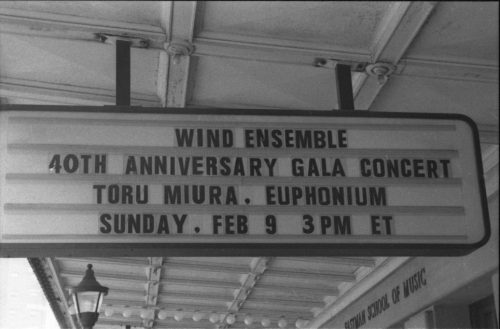 Thirty years ago this week, the Eastman School acknowledged and celebrated the 40th anniversary of the founding of the Eastman Wind Ensemble with a three-day celebration (February 7th-9th) that concluded with a gala concert in the Eastman Theater. The celebration was far more than the commemoration of the founding of a successful ensemble; indeed, it was in recognition of the success of the wind ensemble concept around the world. The three-day celebration incorporated presentations by The Conductors’ Guild and the Sonneck Society for American Music (today the Society for American Music). It is altogether fitting that milestone anniversaries of the Eastman Wind Ensemble – the 25th (1977), the 40th (1992), and the 50th (2002) have been marked with high-profile professional gatherings that have examined and reinforced the commitment to the wind ensemble concept.
Thirty years ago this week, the Eastman School acknowledged and celebrated the 40th anniversary of the founding of the Eastman Wind Ensemble with a three-day celebration (February 7th-9th) that concluded with a gala concert in the Eastman Theater. The celebration was far more than the commemoration of the founding of a successful ensemble; indeed, it was in recognition of the success of the wind ensemble concept around the world. The three-day celebration incorporated presentations by The Conductors’ Guild and the Sonneck Society for American Music (today the Society for American Music). It is altogether fitting that milestone anniversaries of the Eastman Wind Ensemble – the 25th (1977), the 40th (1992), and the 50th (2002) have been marked with high-profile professional gatherings that have examined and reinforced the commitment to the wind ensemble concept.
The gala concert that concluded the celebration brought to the podium each of the three (to that time) music directors of the Eastman Wind Ensemble: Frederick Fennell (1952-62), A. Clyde Roller (1962-64), and Donald Hunsberger (since 1964). A performance of the Concerto for Euphonium by Joseph Horovitz featured as soloist Toru Miura of the Tokyo Kosei Wind Orchestra, who had given a euphonium master class in Kilbourn Hall on the evening preceding the formal start of the celebration. The gala concert’s program represented a thorough retrospective of 20th-century compositions for winds, and in a most appropriate acknowledgement of Eastman history, the program included a performance of A Nostalgic Jazz Odyssey (1970) by John T. Williams (yes, that John Williams!) which had been composed expressly for the EWE. At the concert’s intermission, Dr. Donald Hunsberger was presented with the National Band Association Academy of Wind and Percussive Arts Society Award by Edward Lisk, President of the NBA.
The 40th anniversary celebration was followed by the publication of the volume The Wind Ensemble and Its Repertoire: Essays on the fortieth anniversary of the Eastman Wind Ensemble, edited by Frank J. Cipolla and Donald Hunsberger (University of Rochester Press, c1994). The volume is one title in the Donald Hunsberger Wind Library, and it represents an essential volume for the history and bibliography of the EWE in particular and the wind ensemble concept in general.
► Photos by Louis Ouzer. Master negative nos. R4037 : R4043
► Printed program
► Dr. Donald Hunsberger, conductor of the Eastman Wind Ensemble since 1964, is presented with the National Band Association Academy of Wind and Percussive Arts Society Award by Edward Lisk, President of the NBA. R4037-2, R4037-4, R4037-5.
► The Eastman Wind Ensemble on-stage in the Eastman Theater: first under Frederick Fennell, and then under Donald Hunsberger, with tuba soloist Toru Miura. R4041-17, R4041-18, R4041-20, R4041-21
The Weekly Dozen
In this week’s Weekly Dozen we recognize an unusual operatic performance that saw a leading soprano performing with the American Opera Company, which had gotten its start at the Eastman School; the Eastman Marimba Ensemble in its public debut; a recital performance by the Eastman Brass Quintet, still in its first decade of existence; and some superlative student performances such as grace the Eastman concert calendar each week of the semester.
►February 8, 1967: Eastman Marimba Ensemble (first concert)







